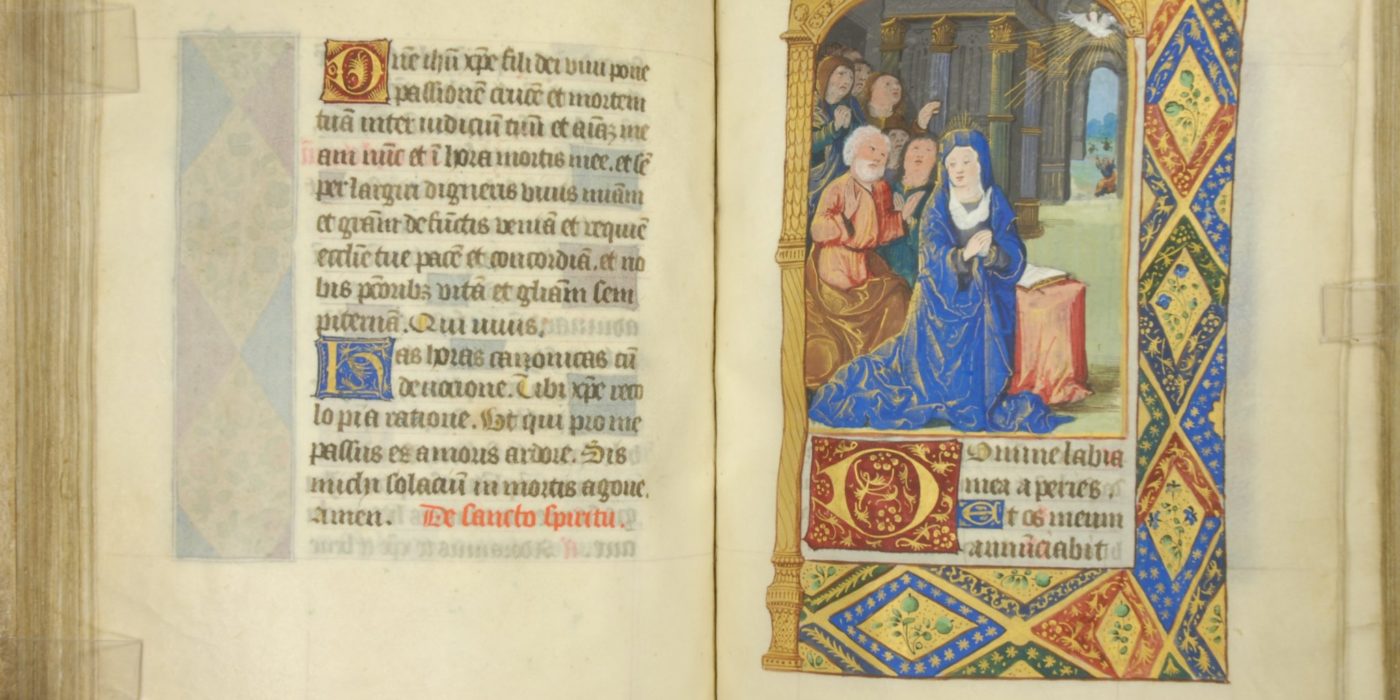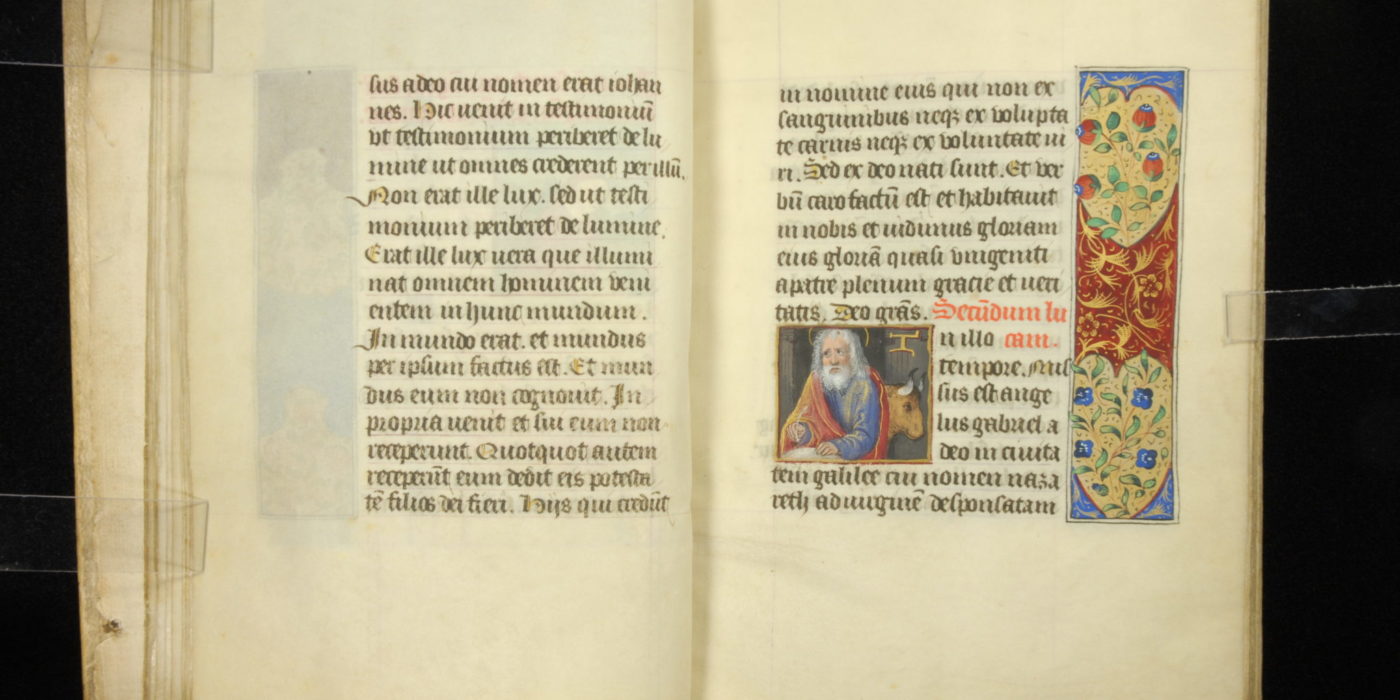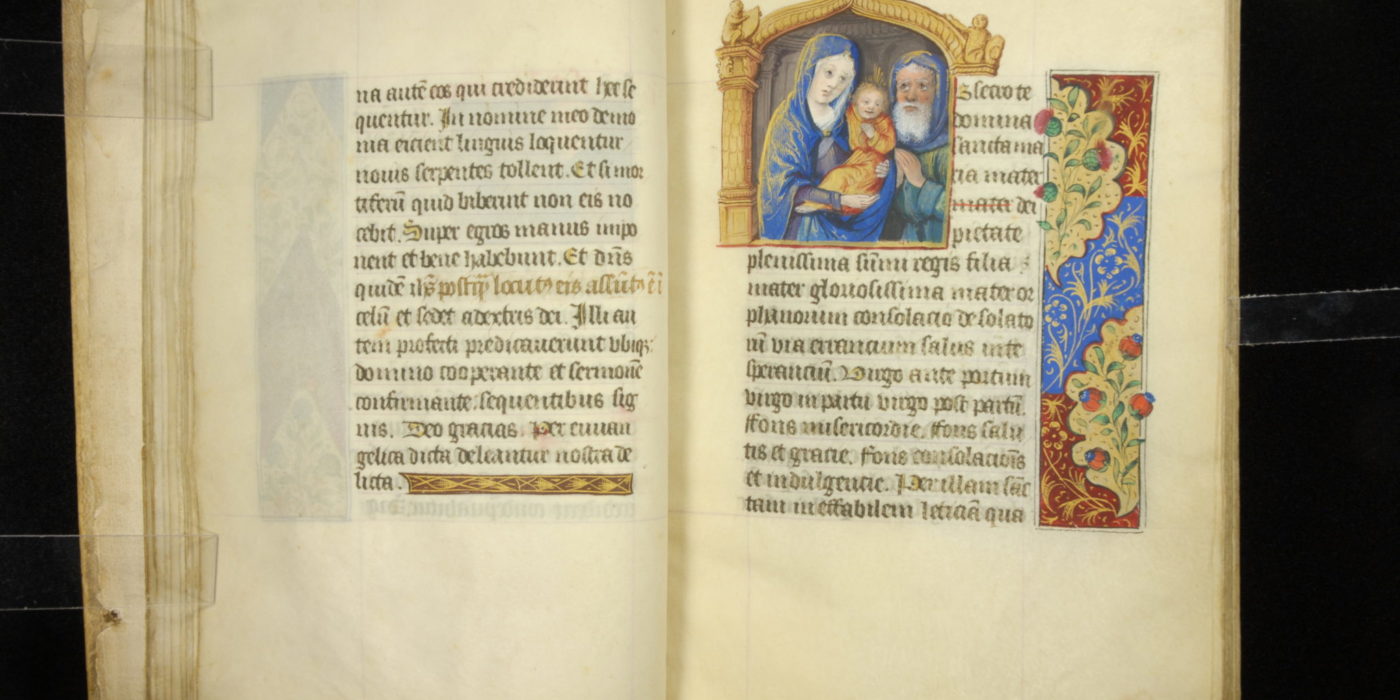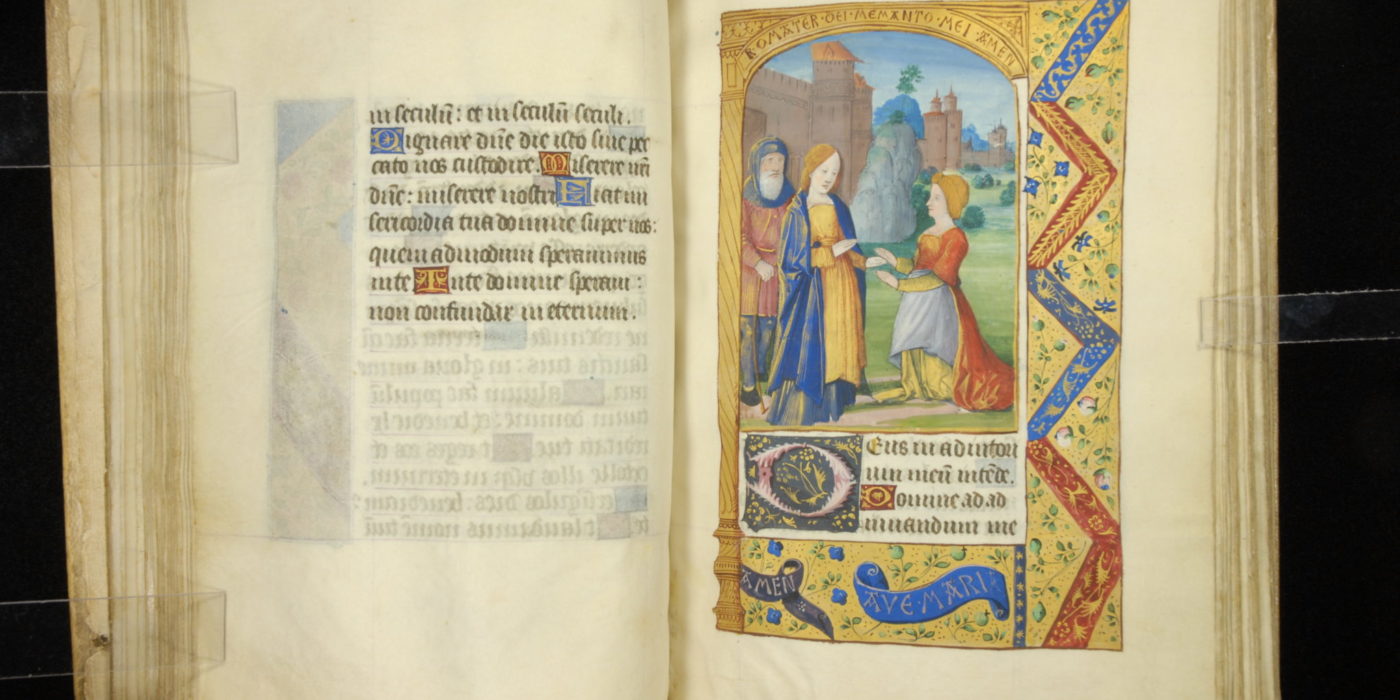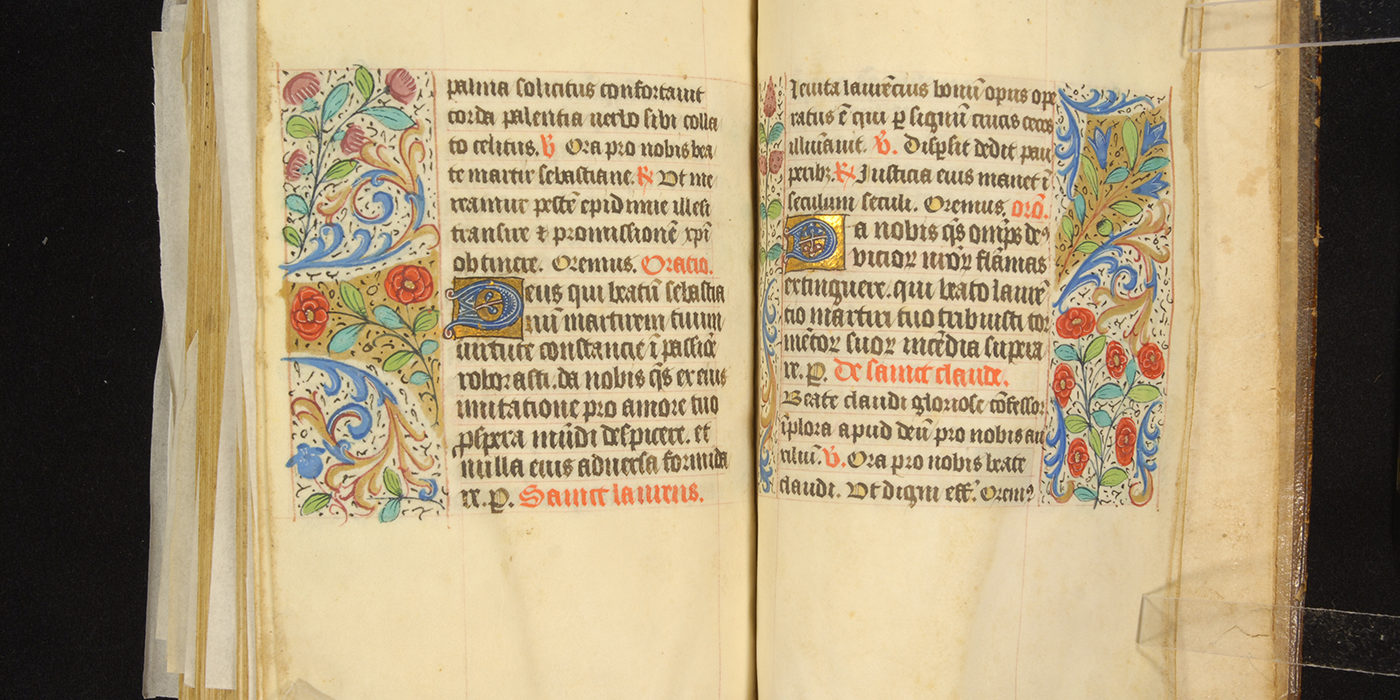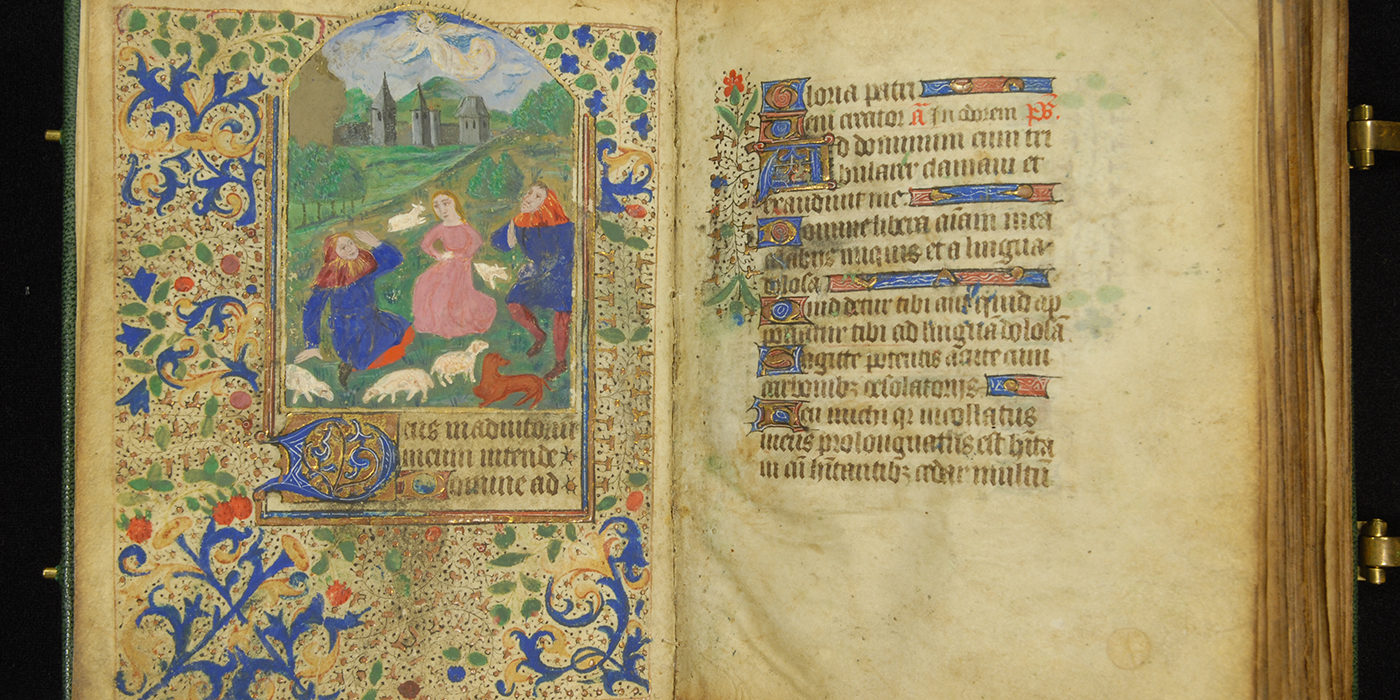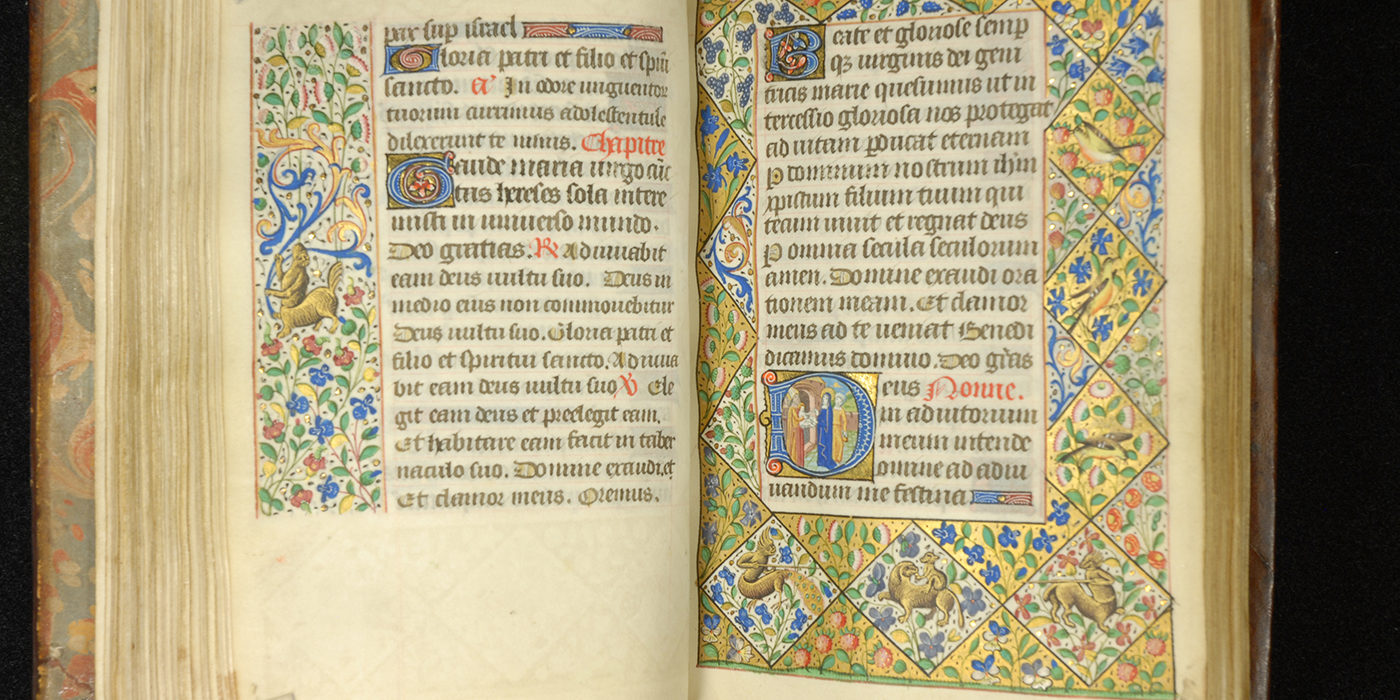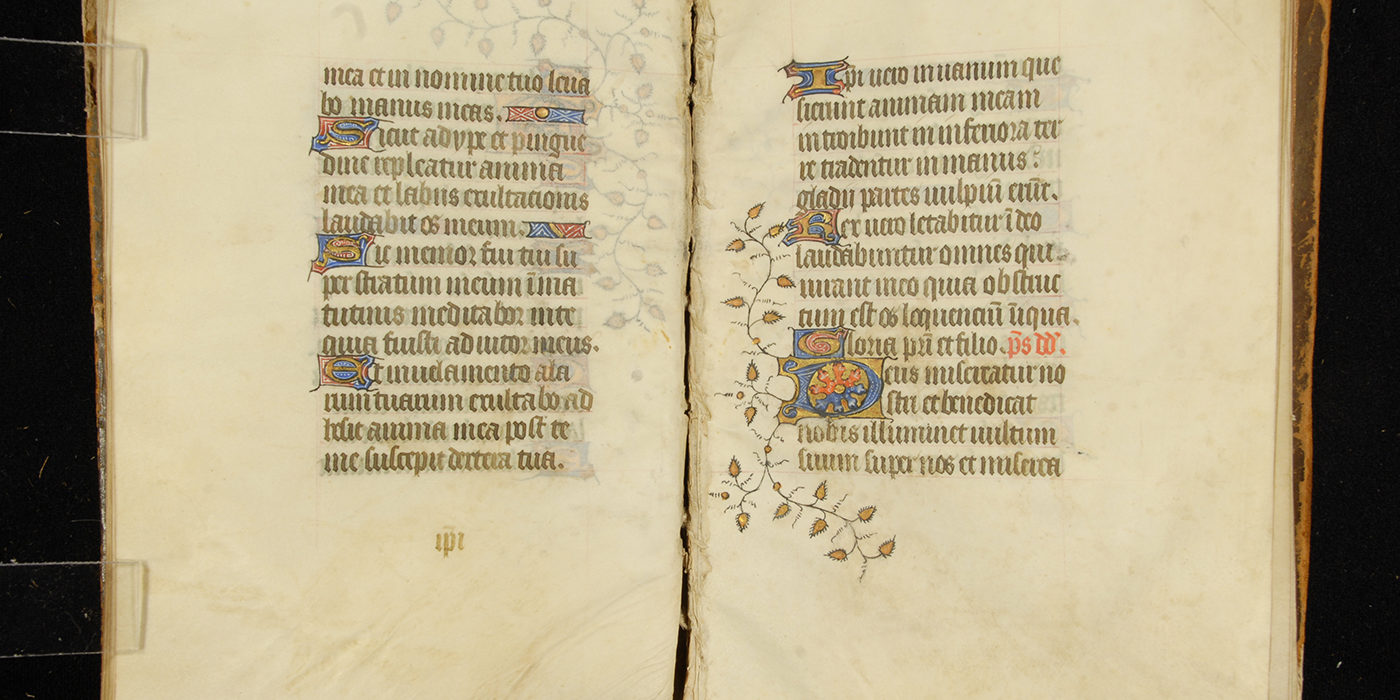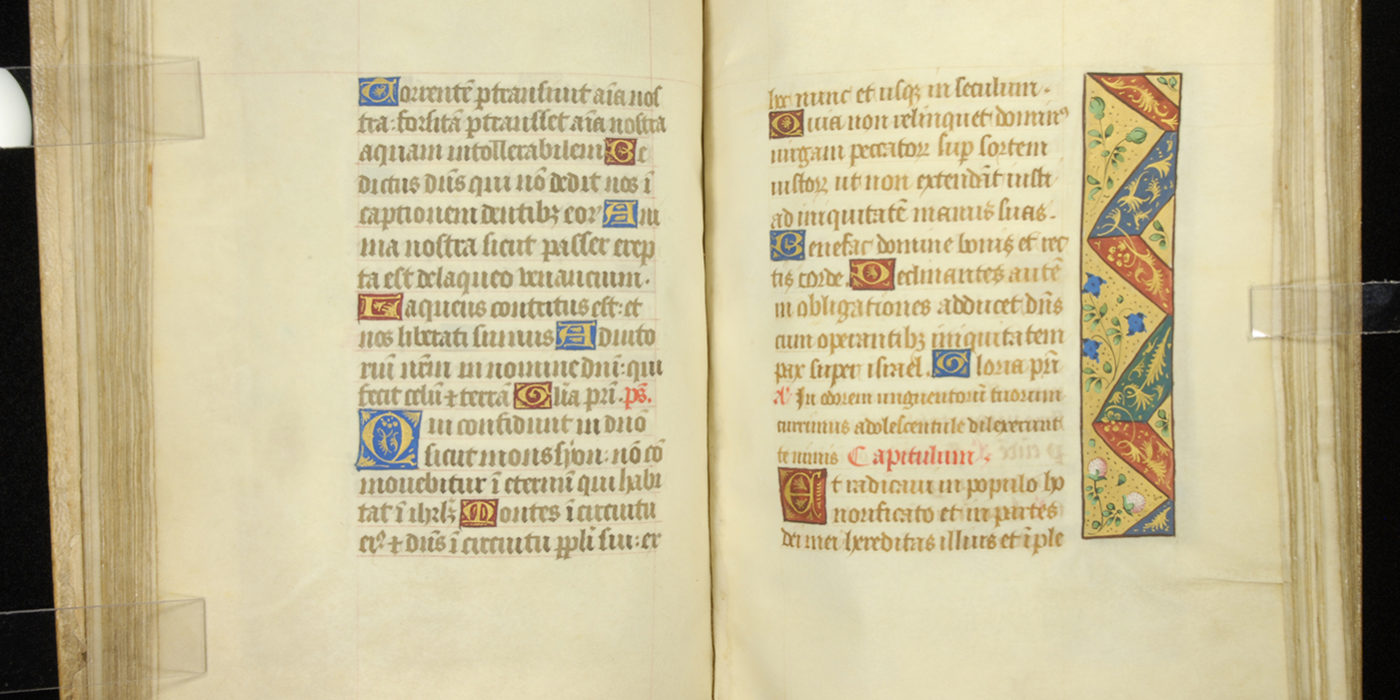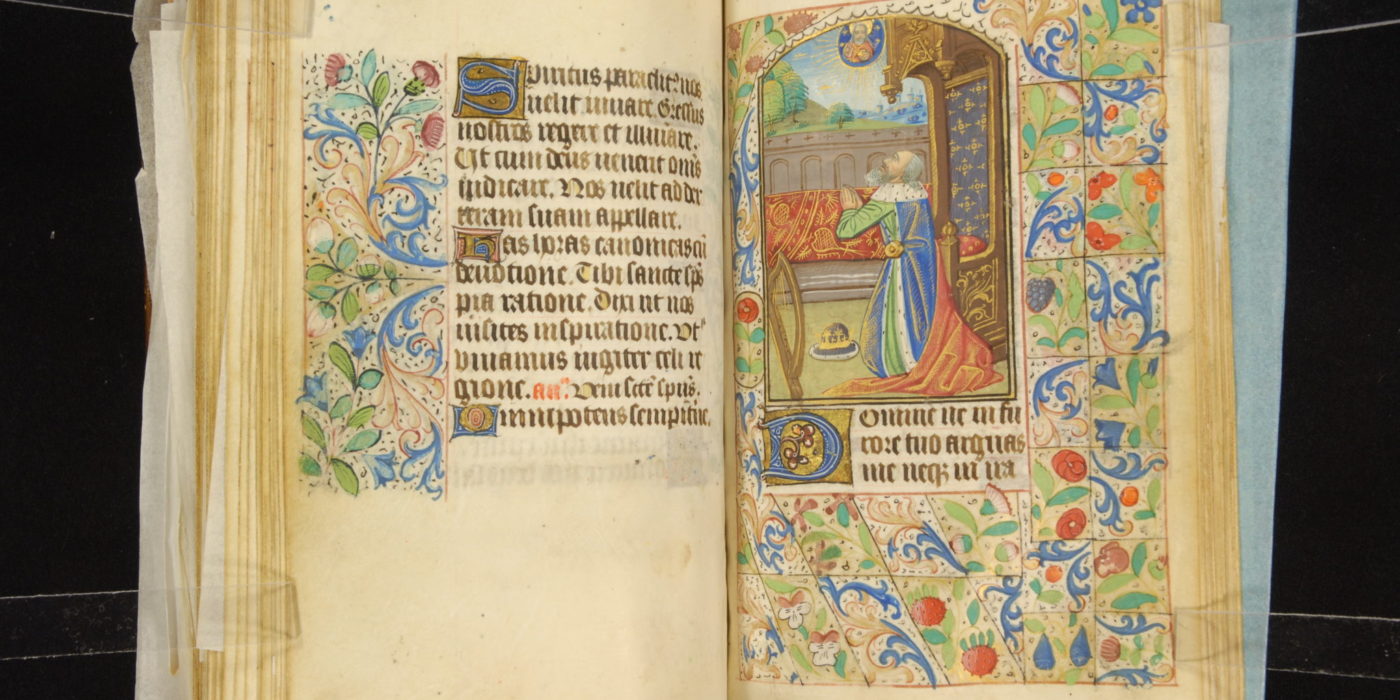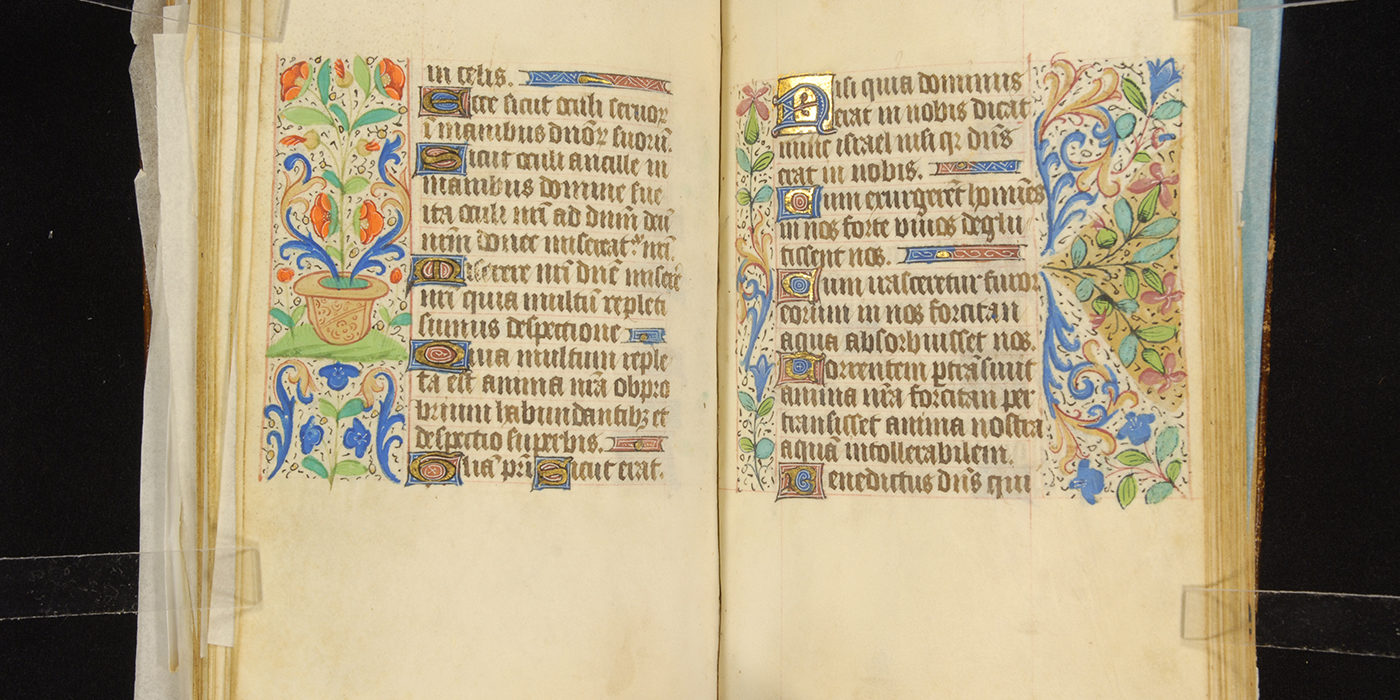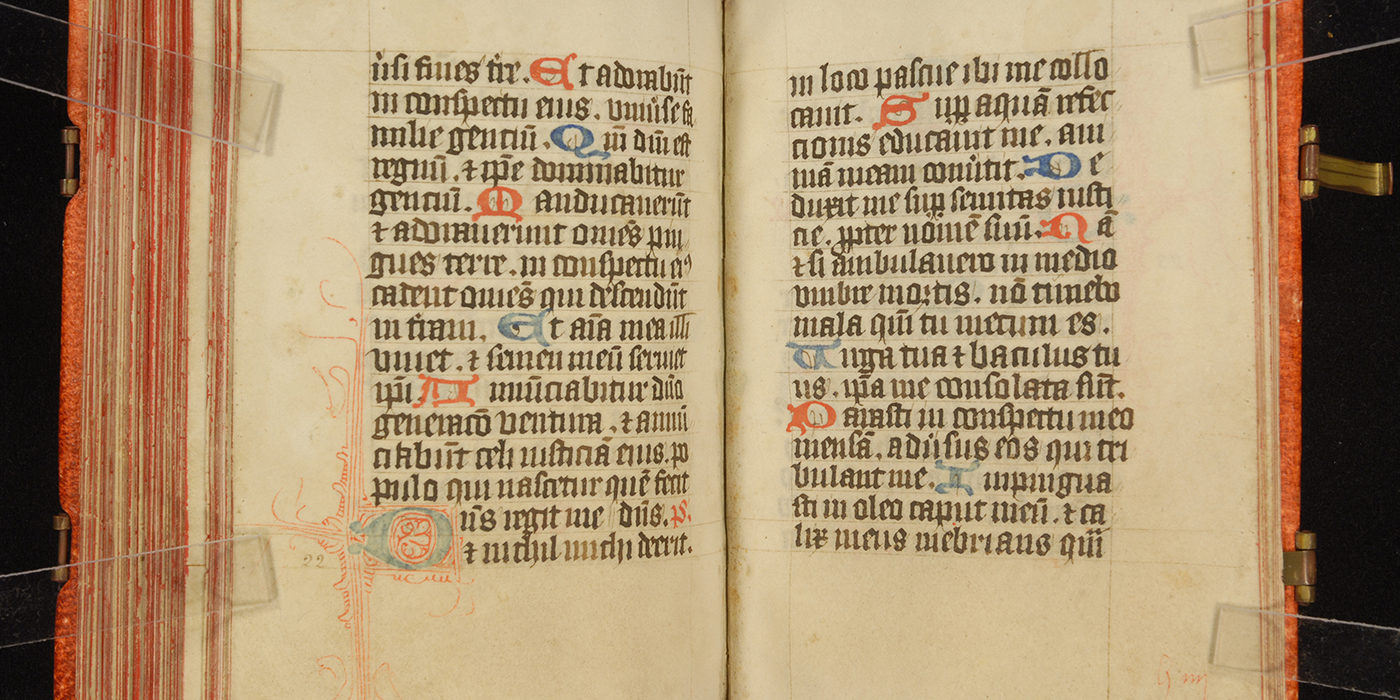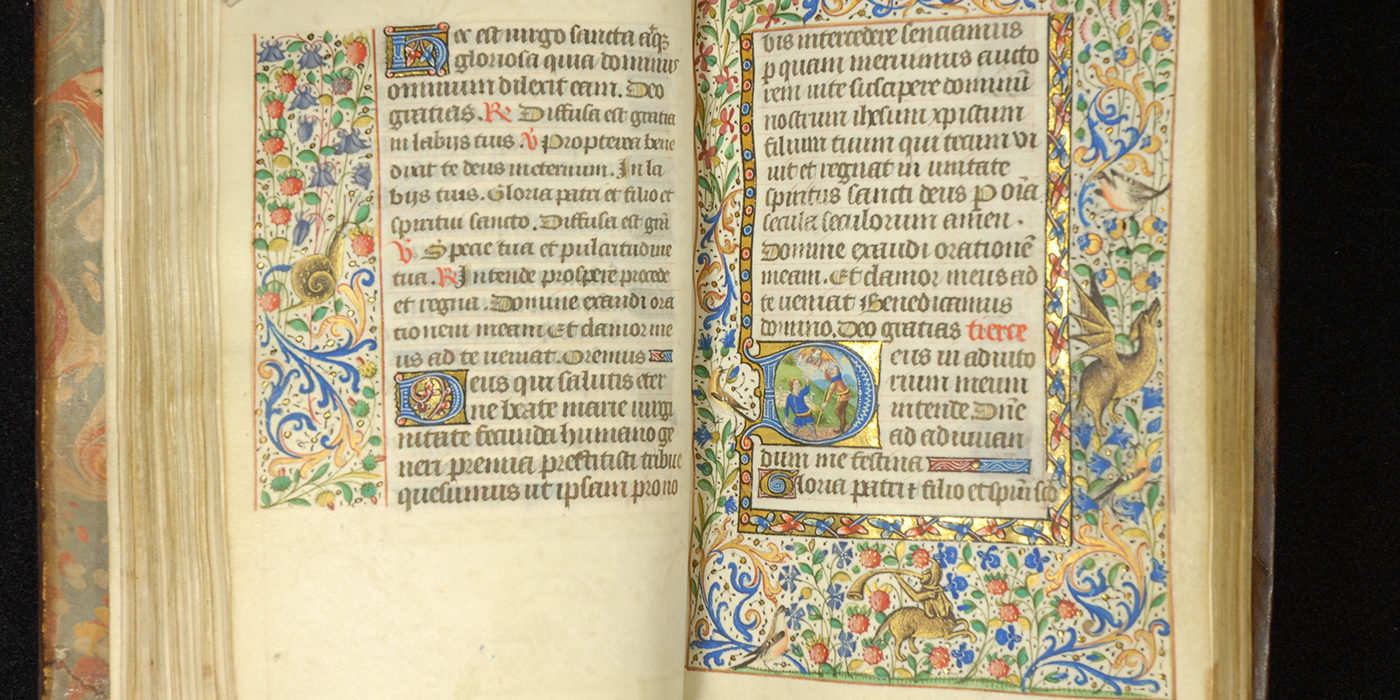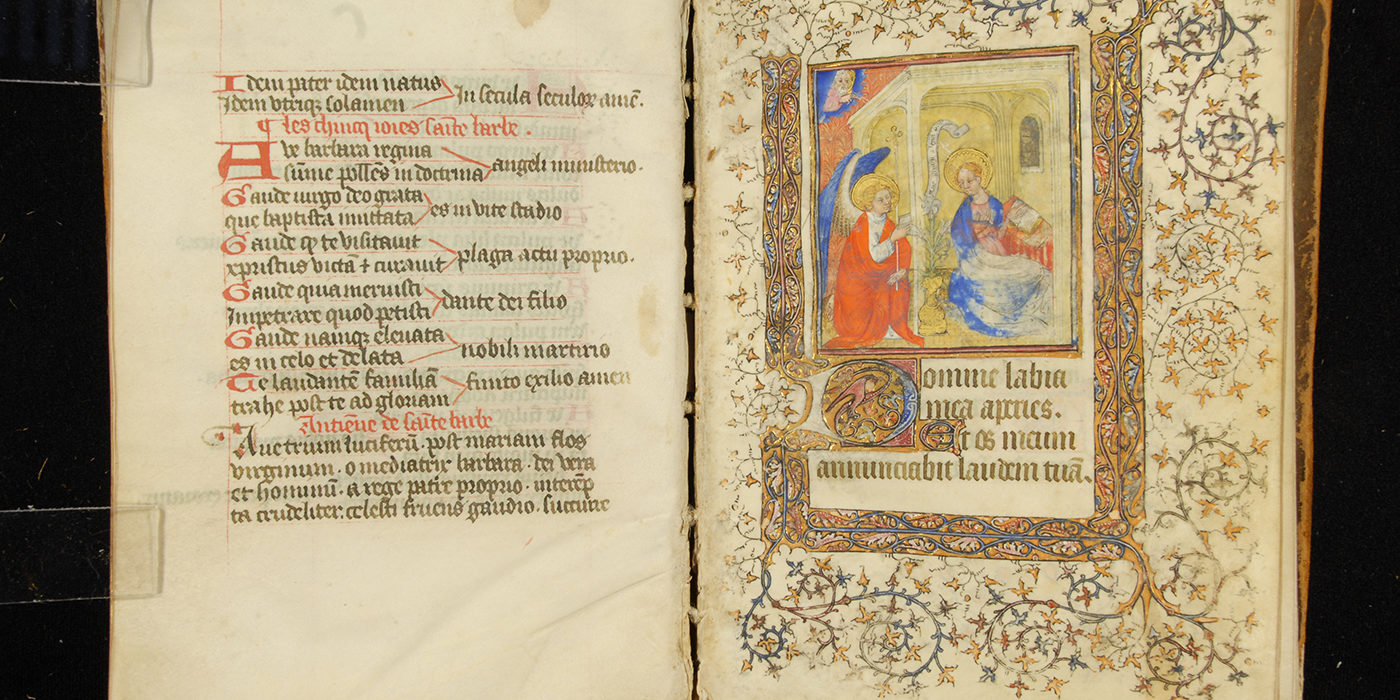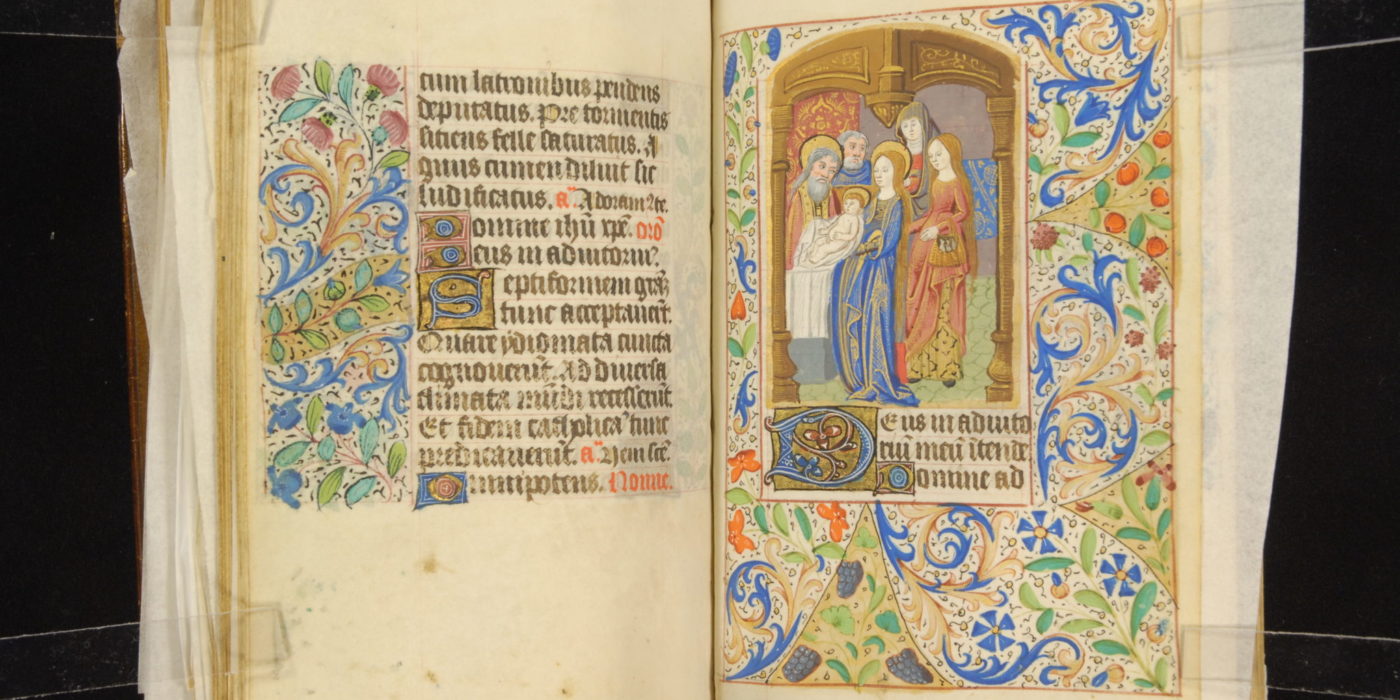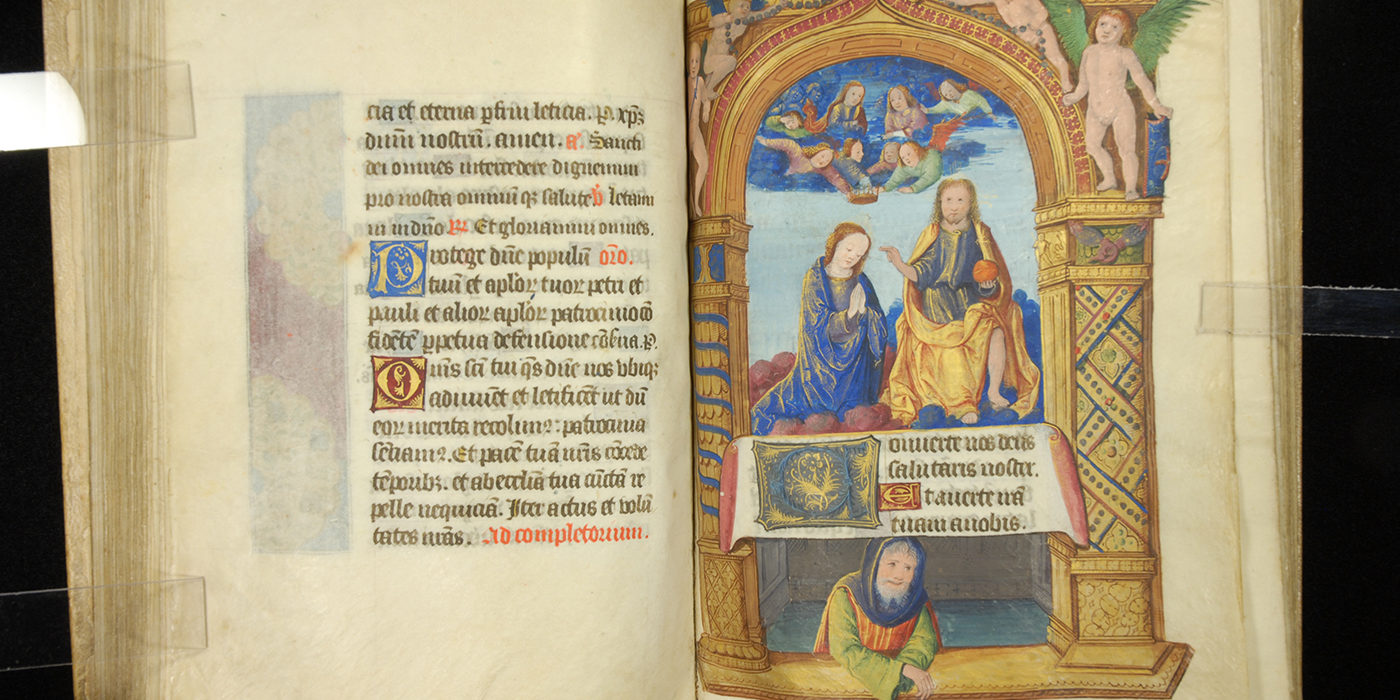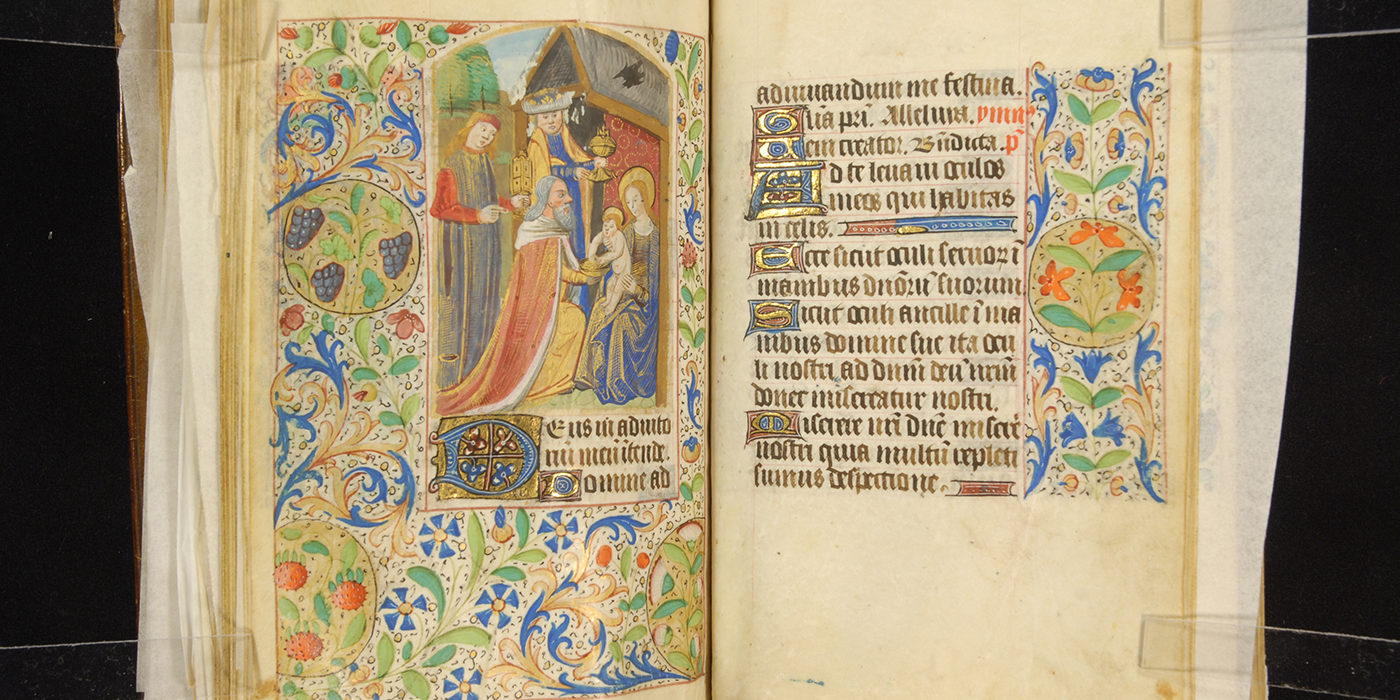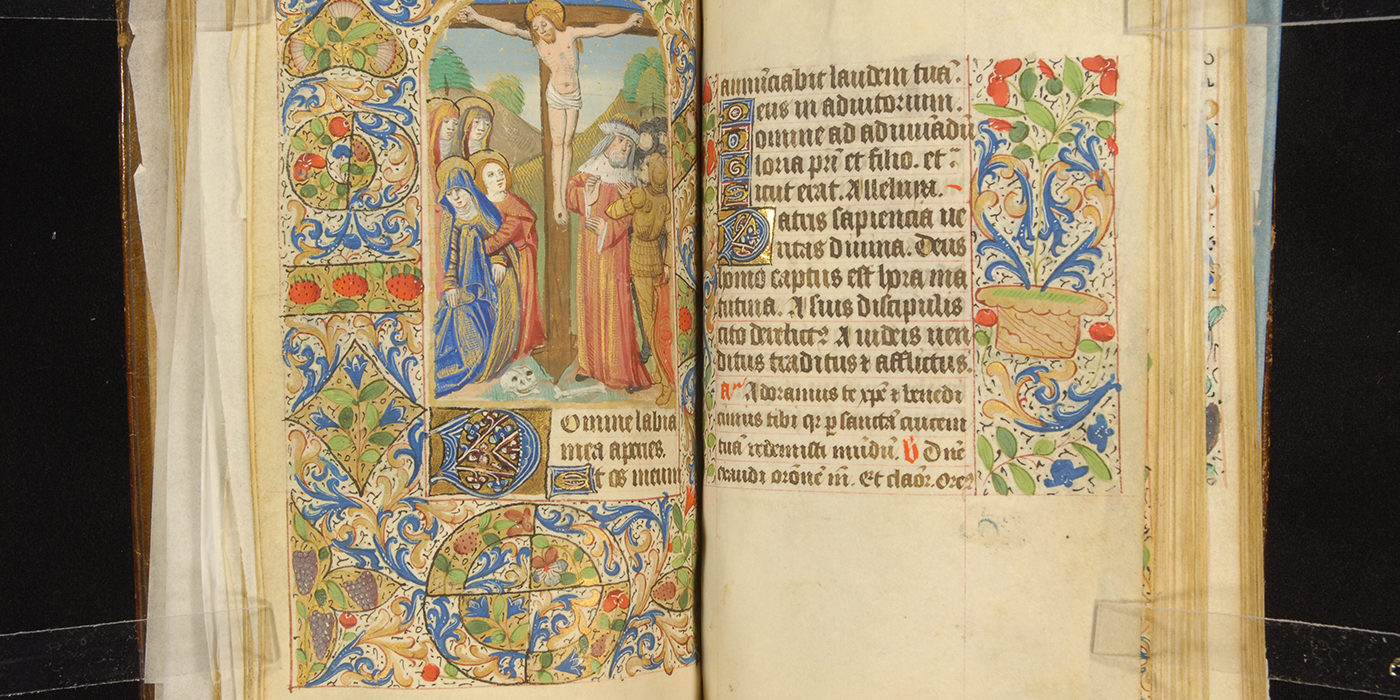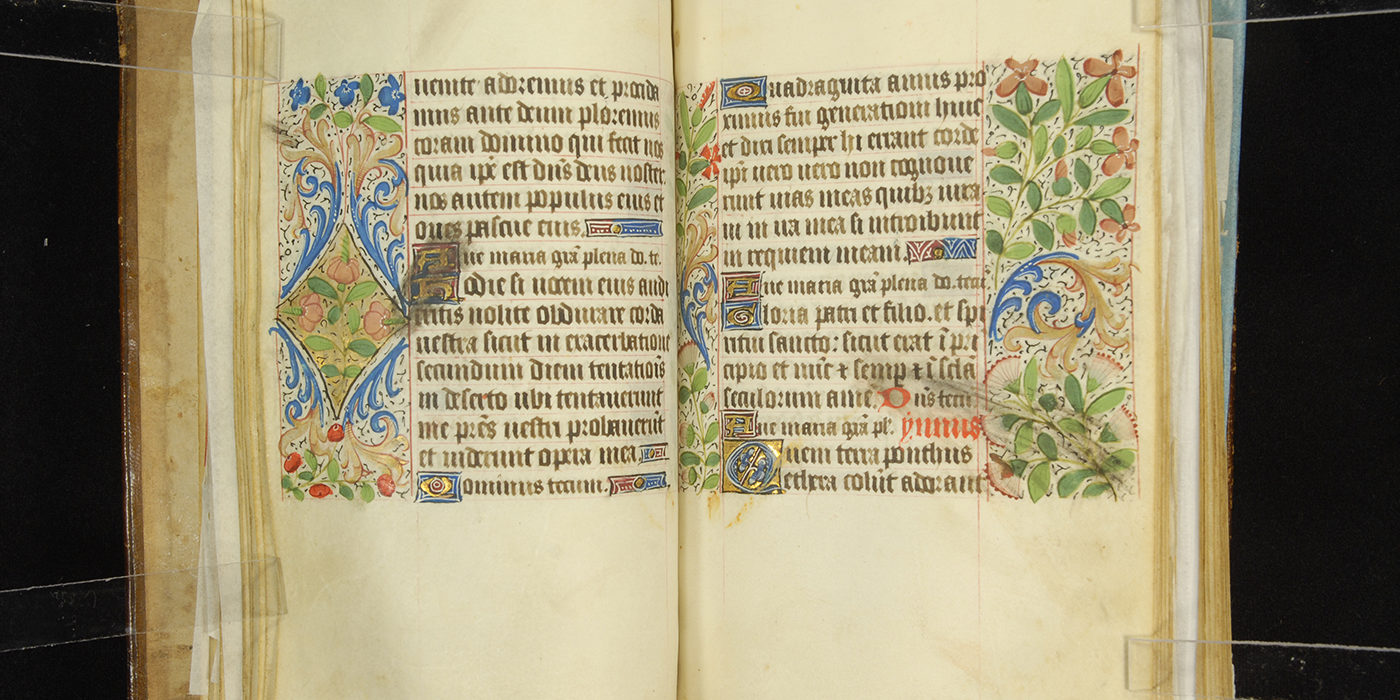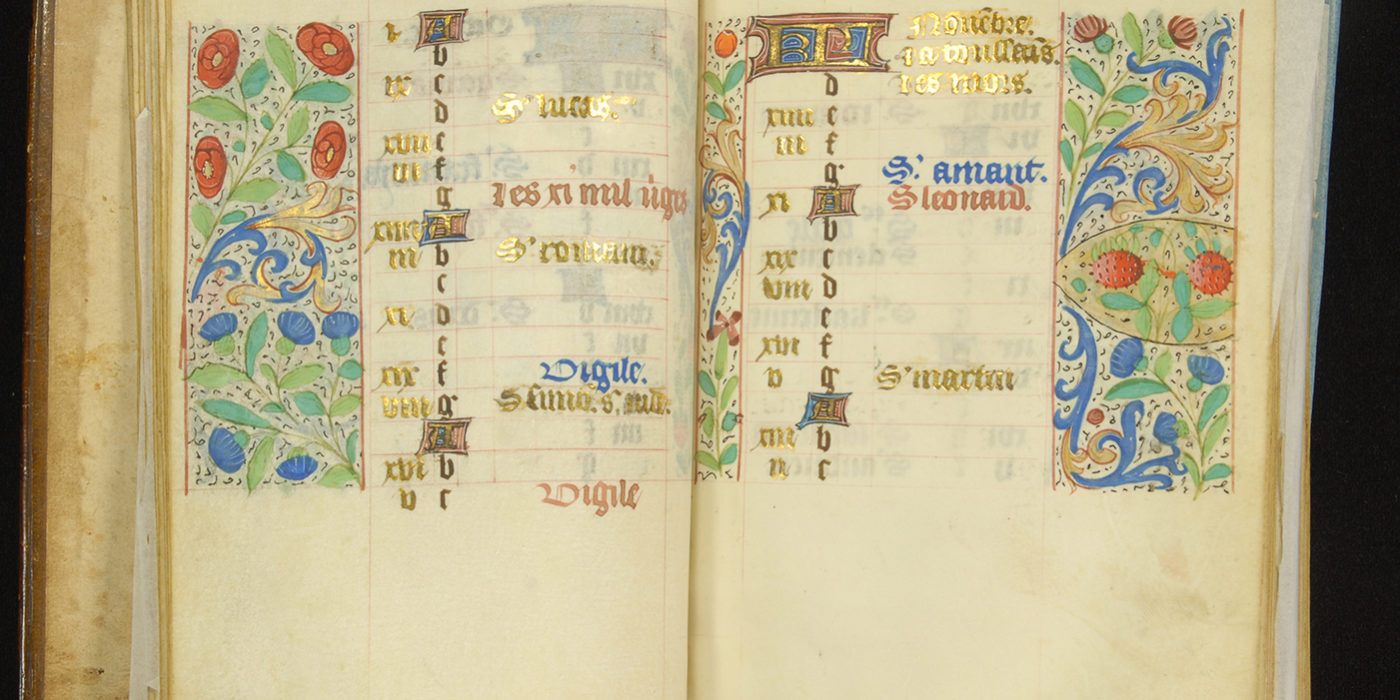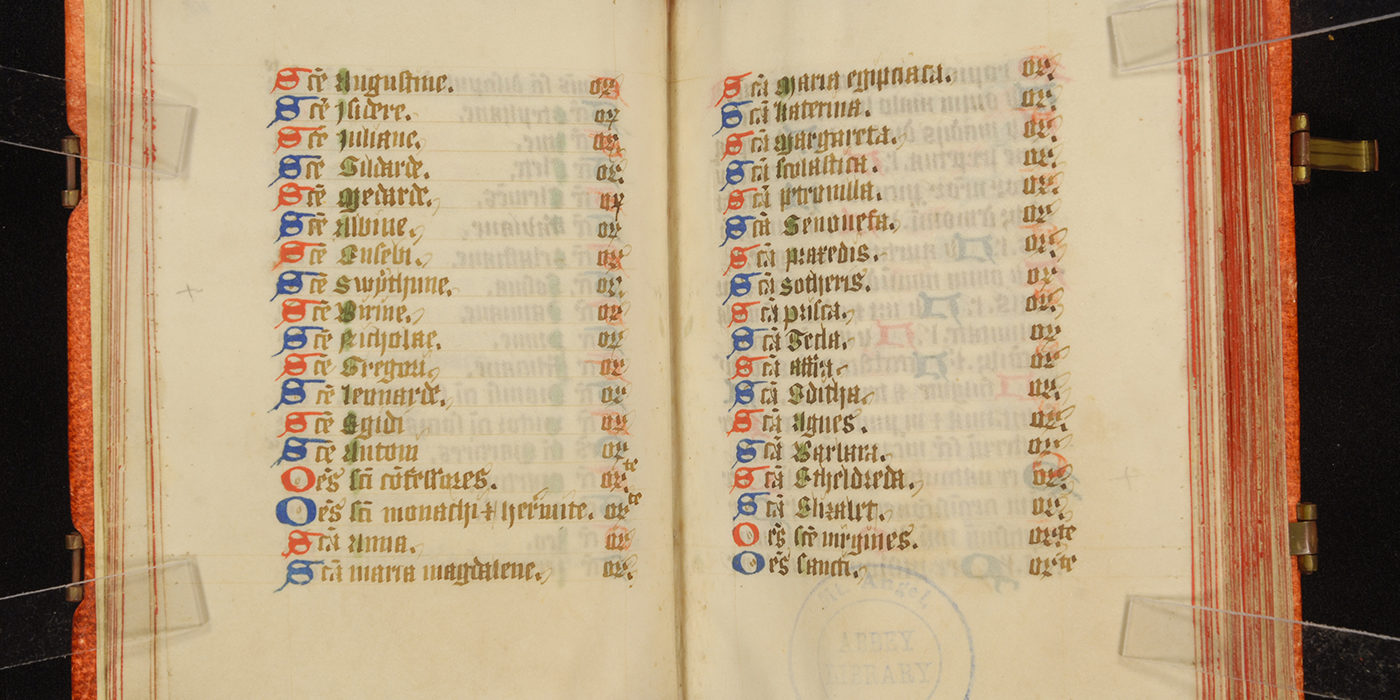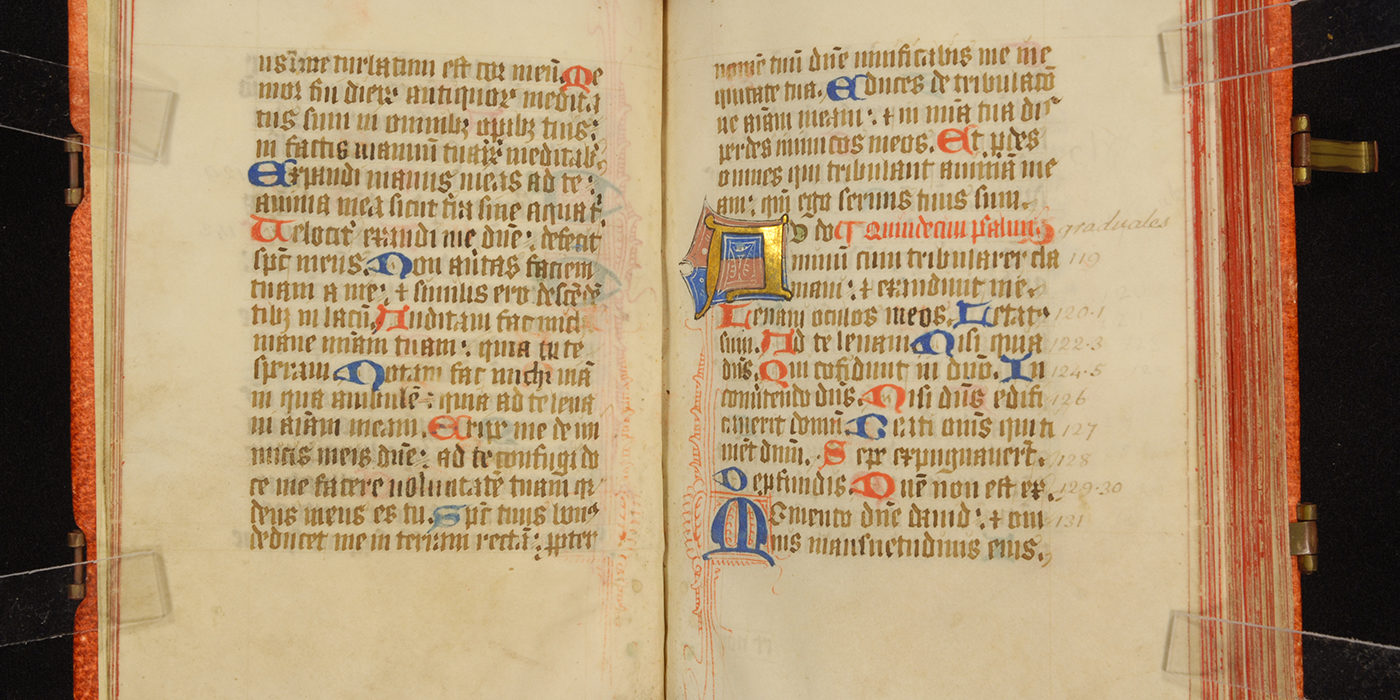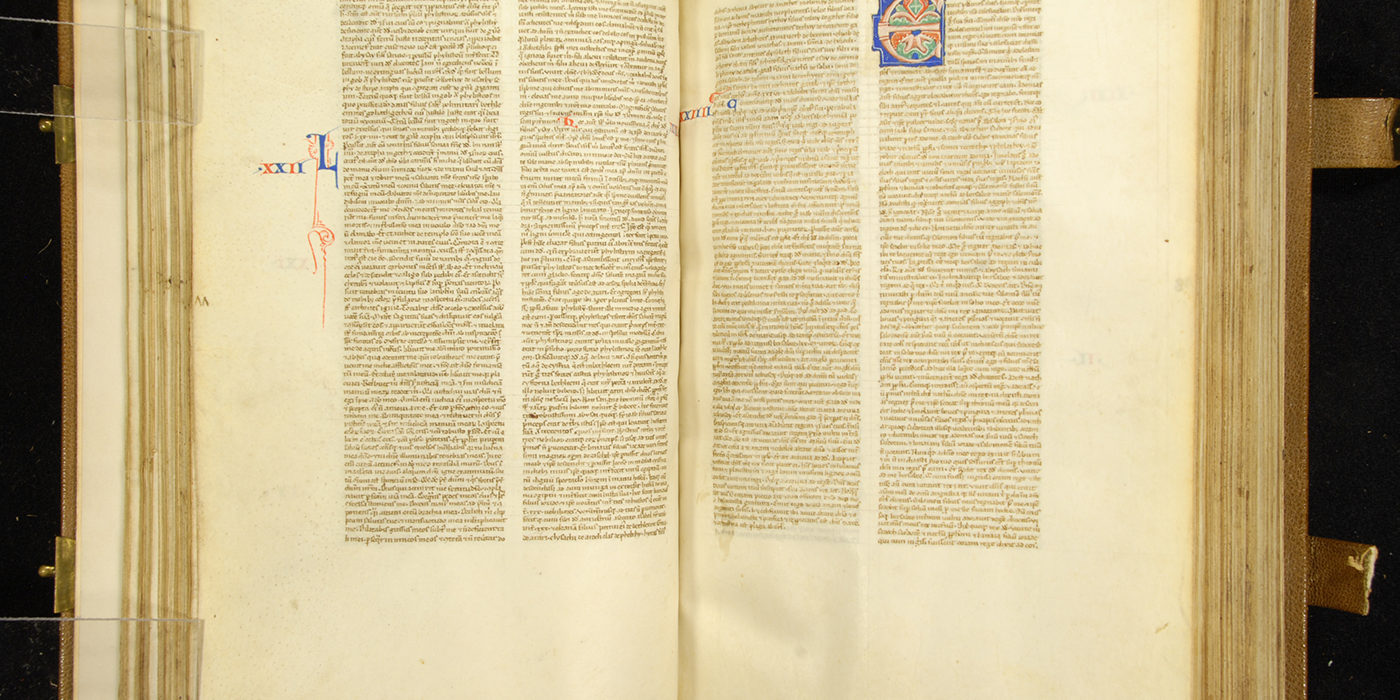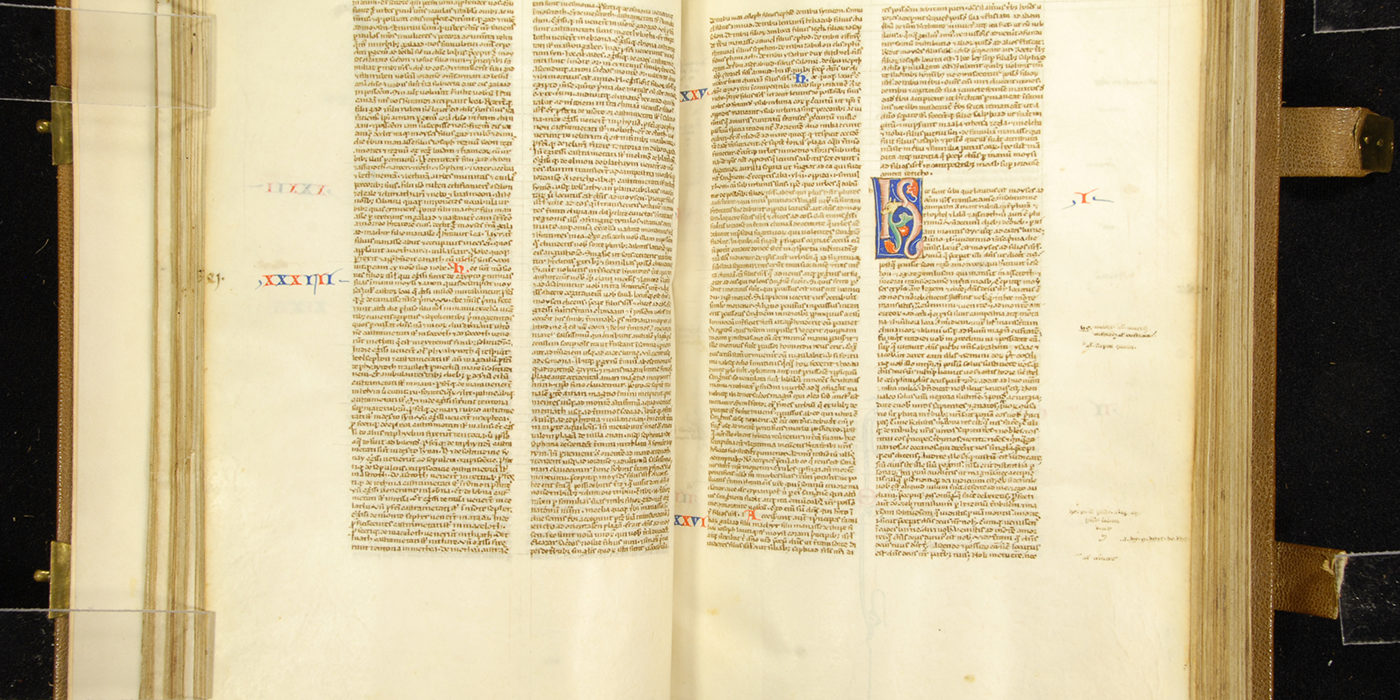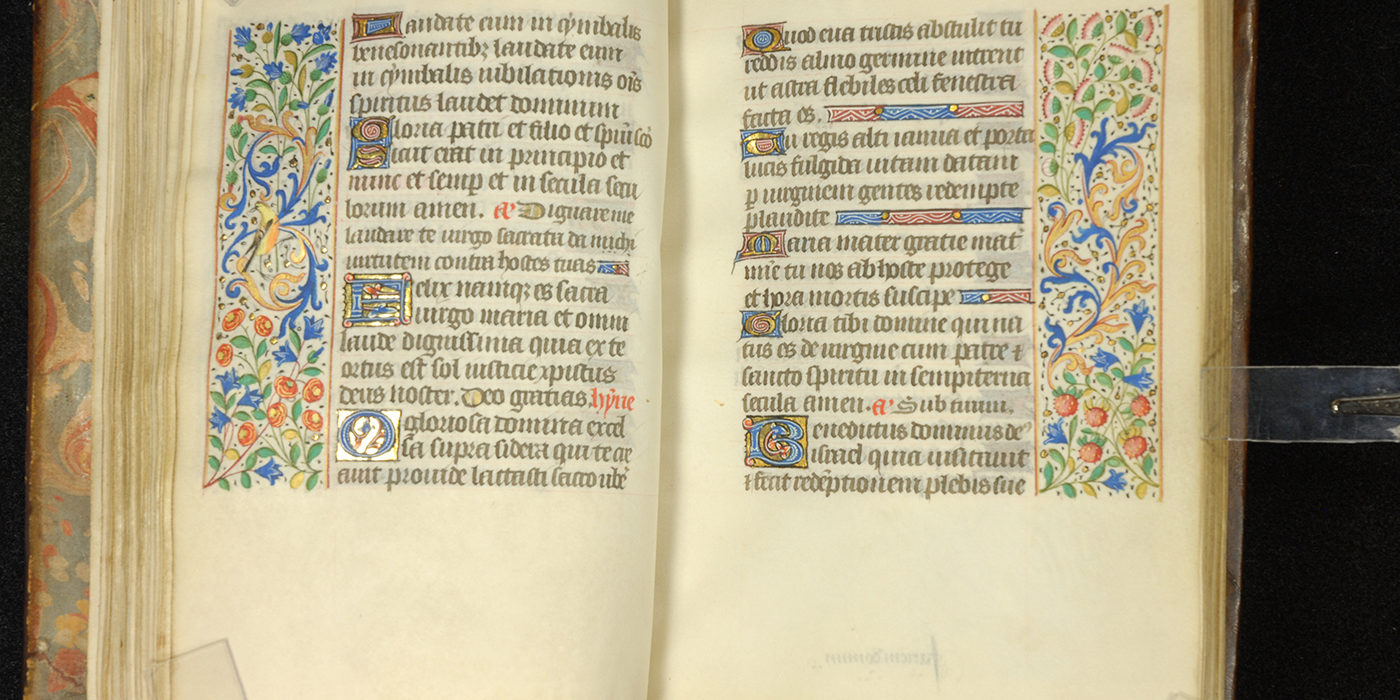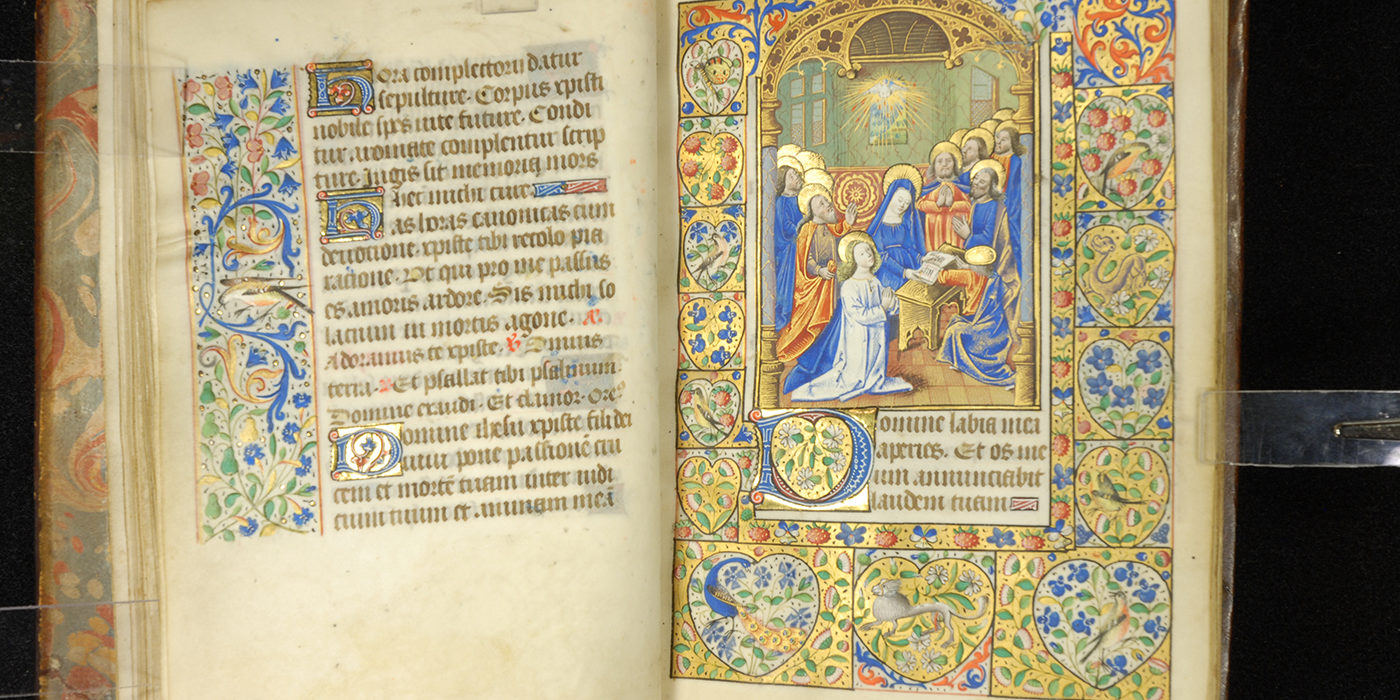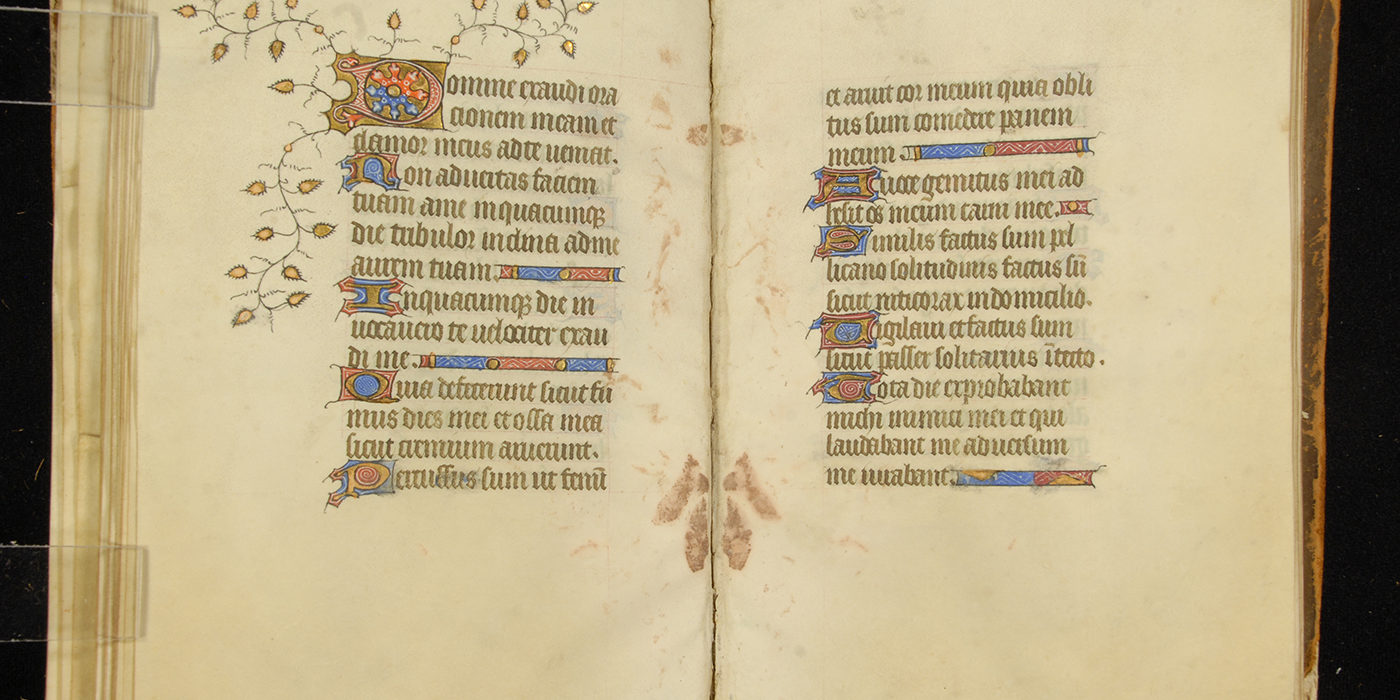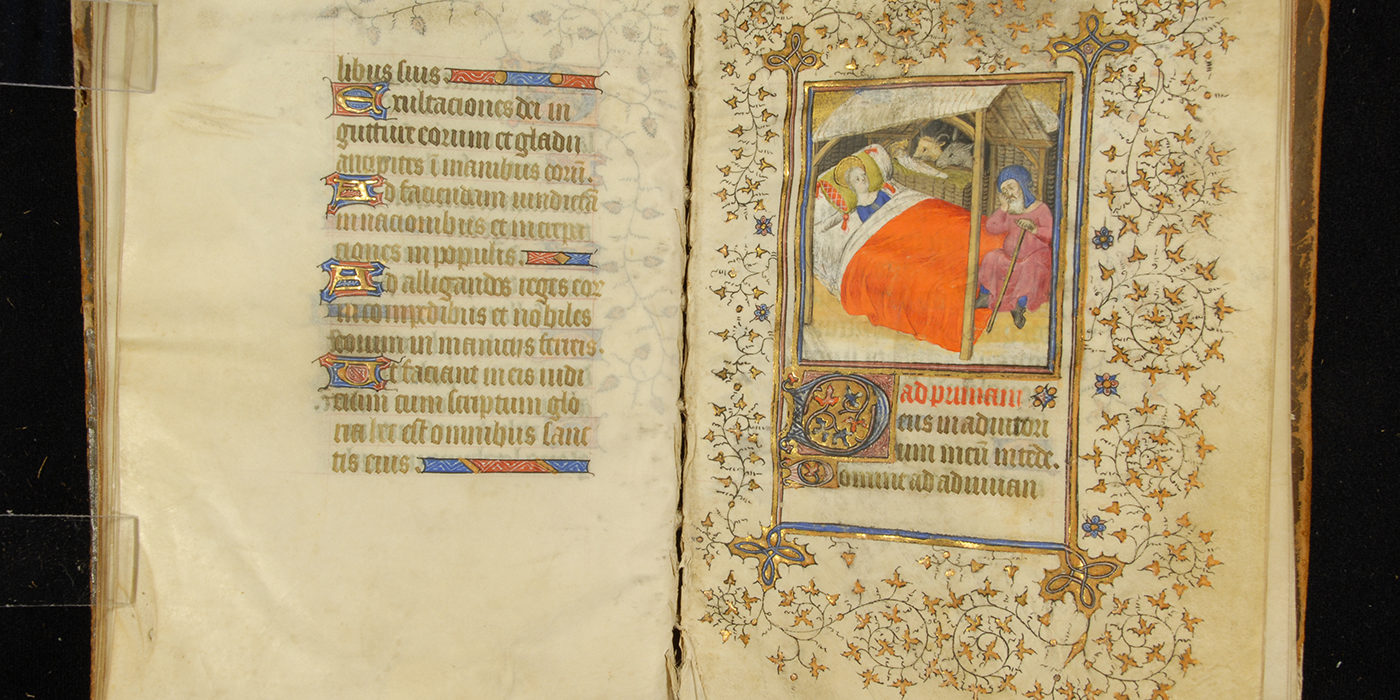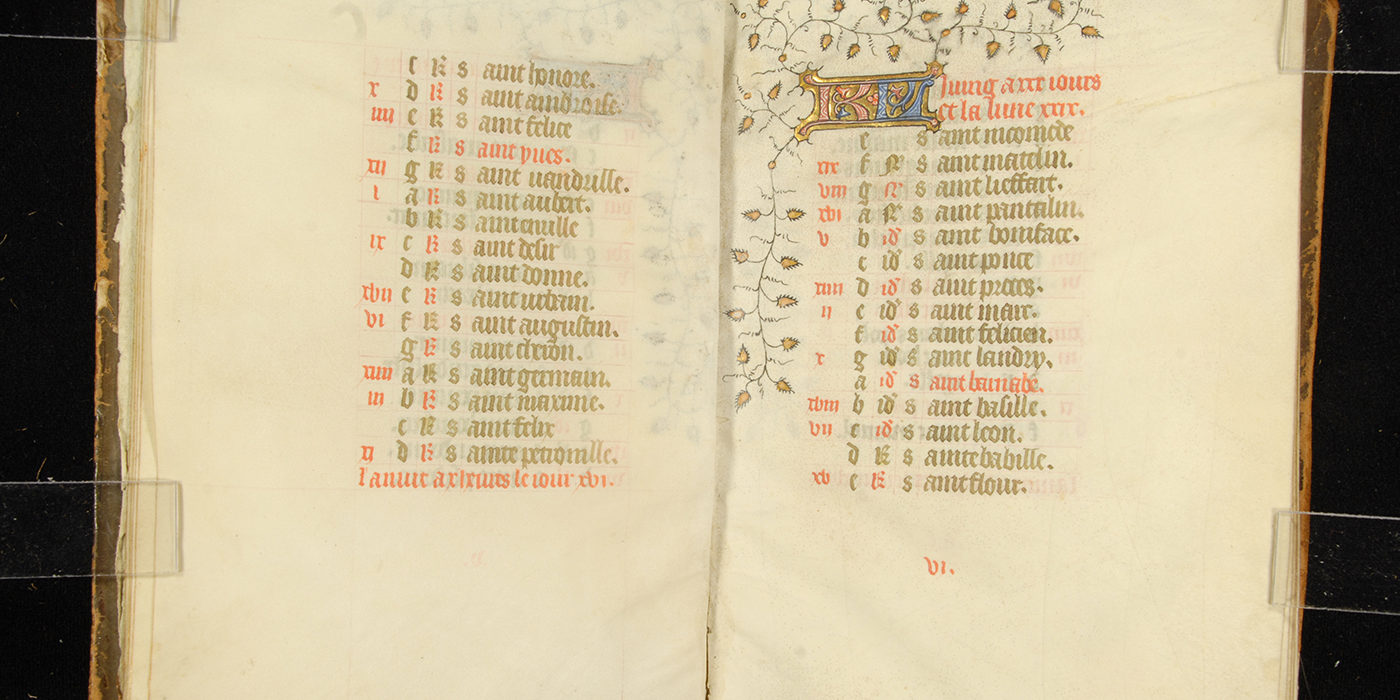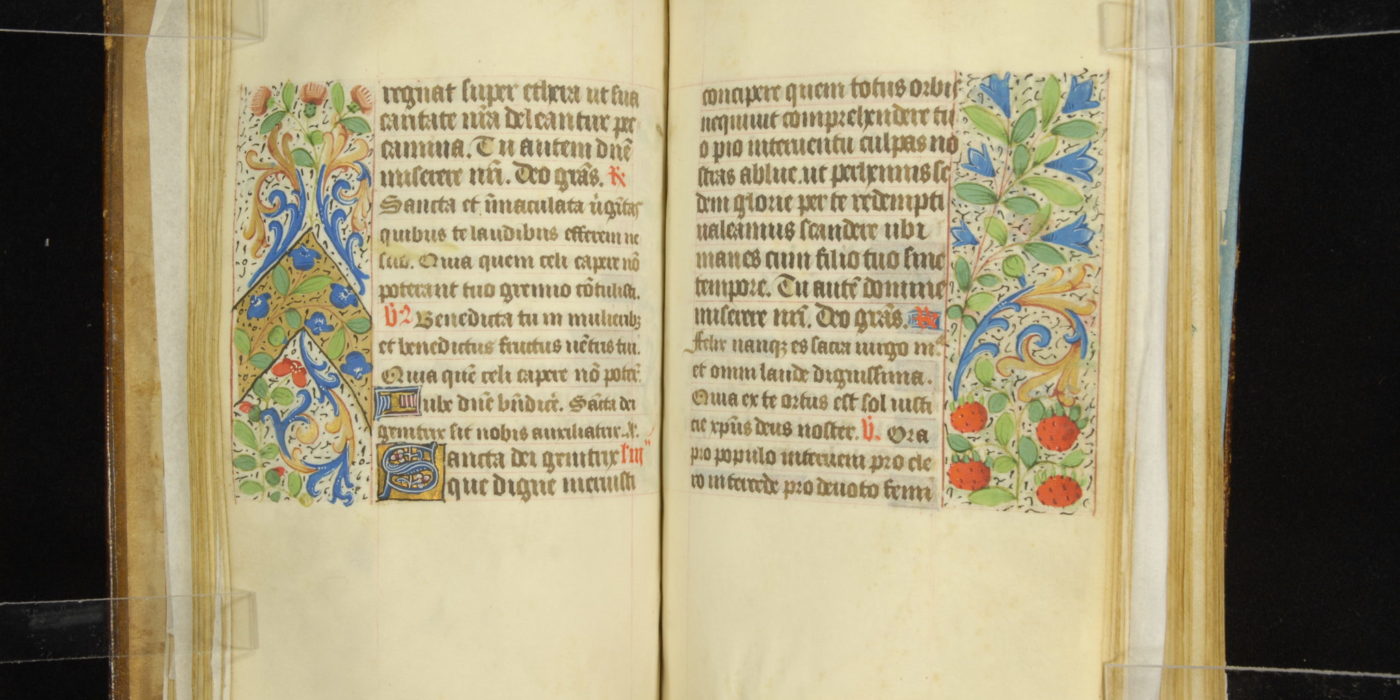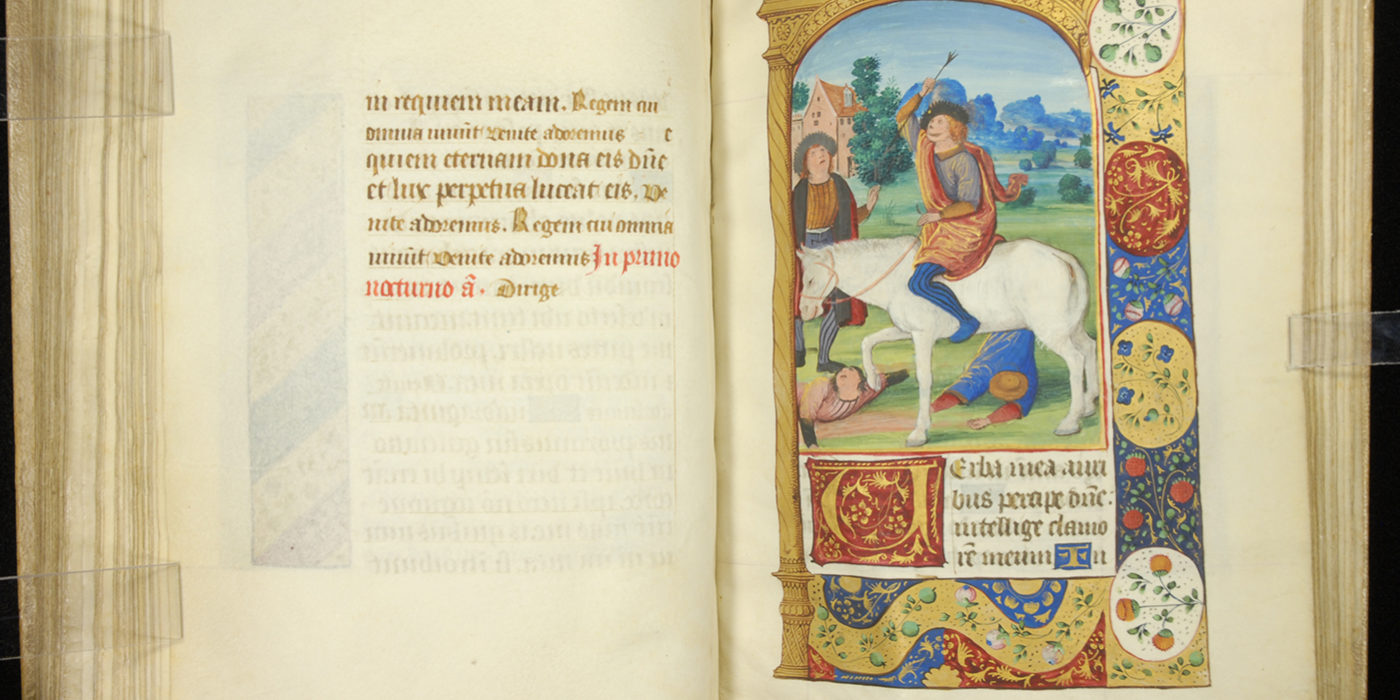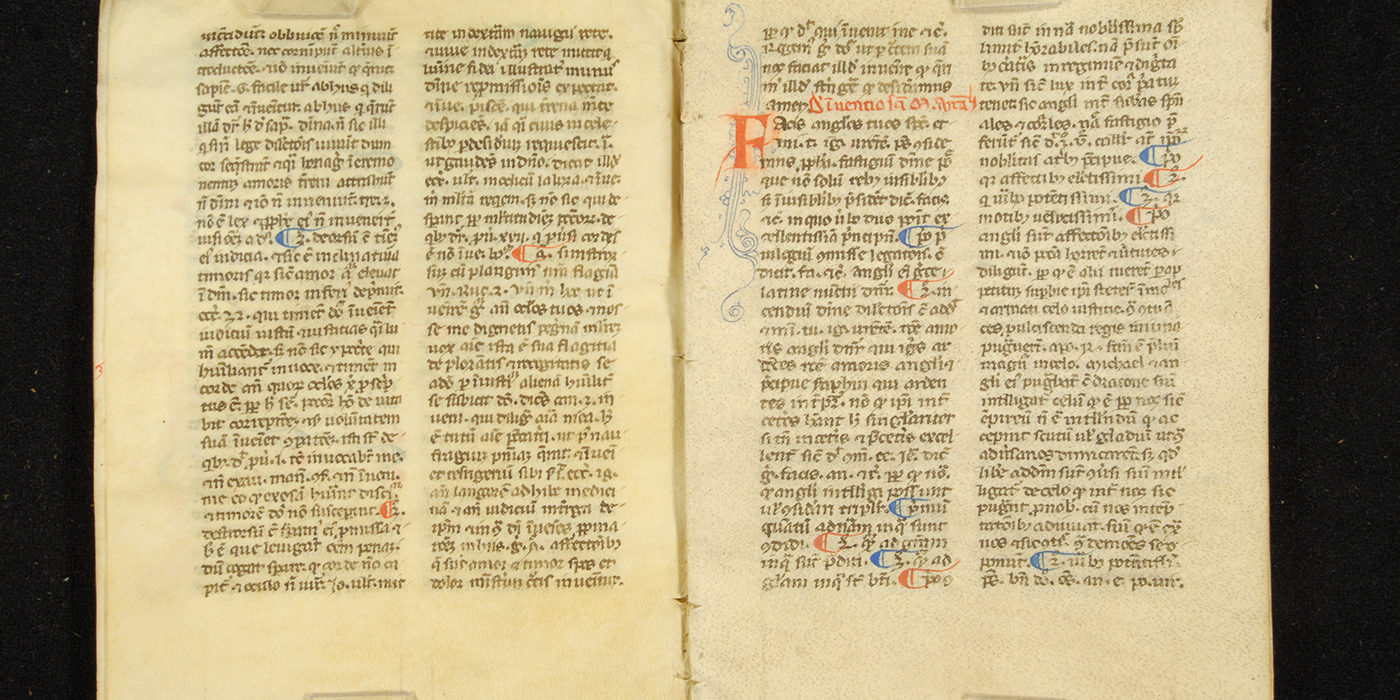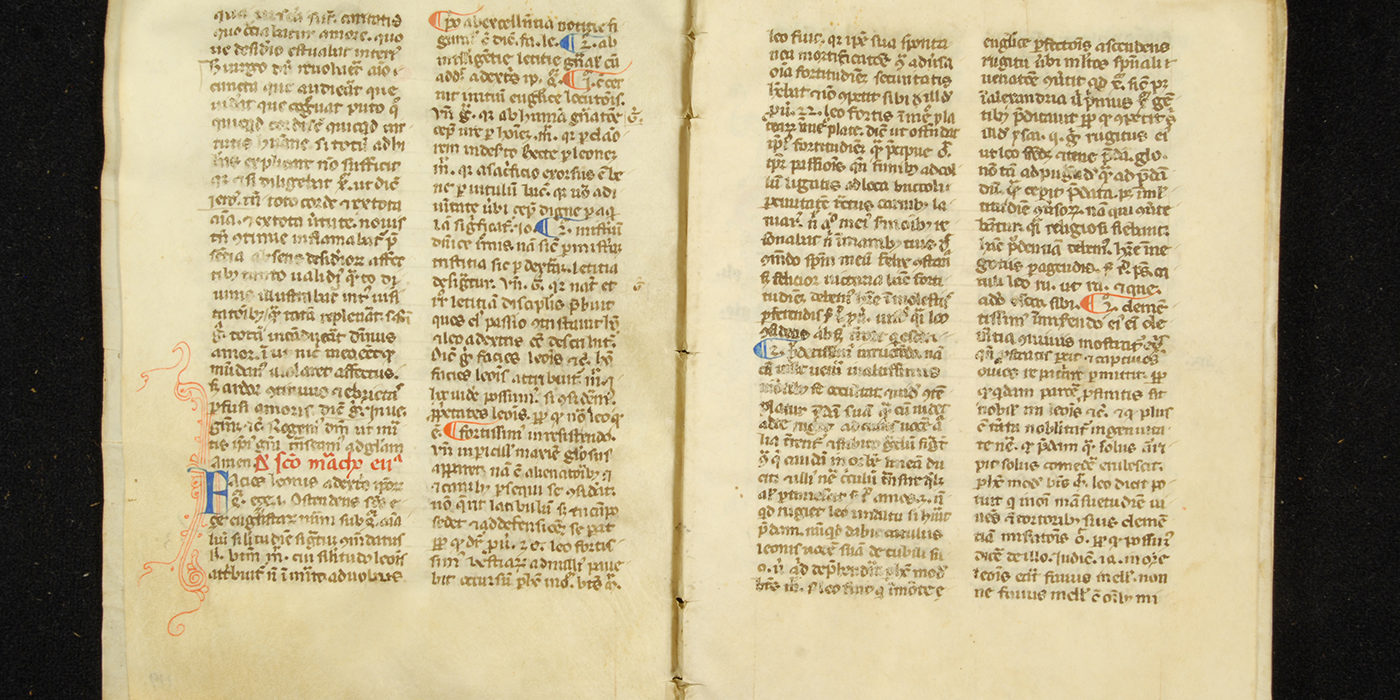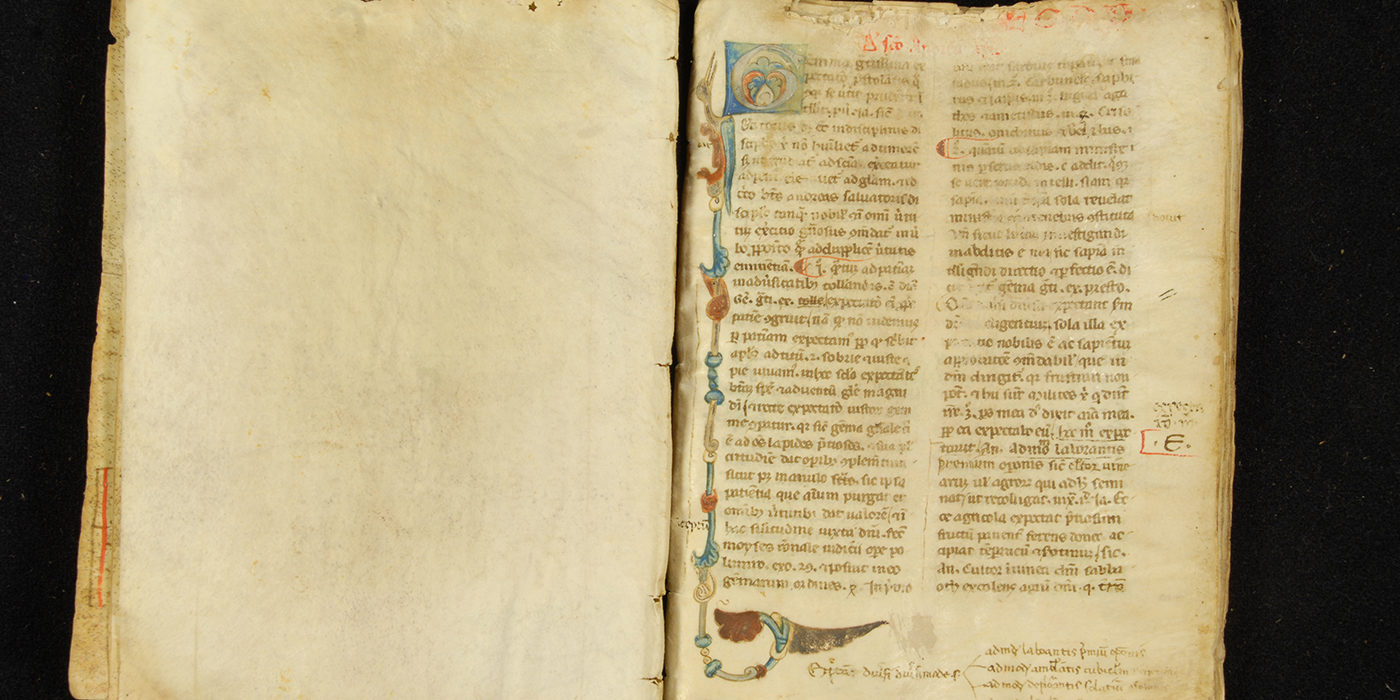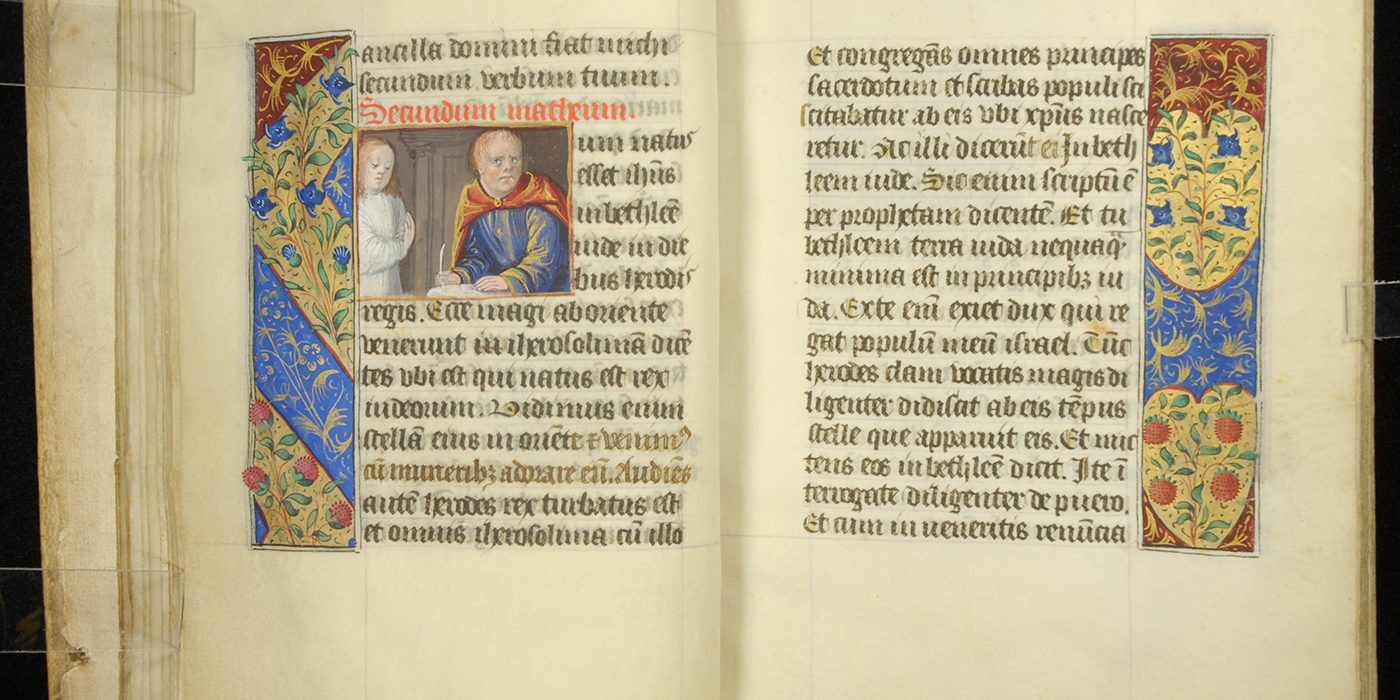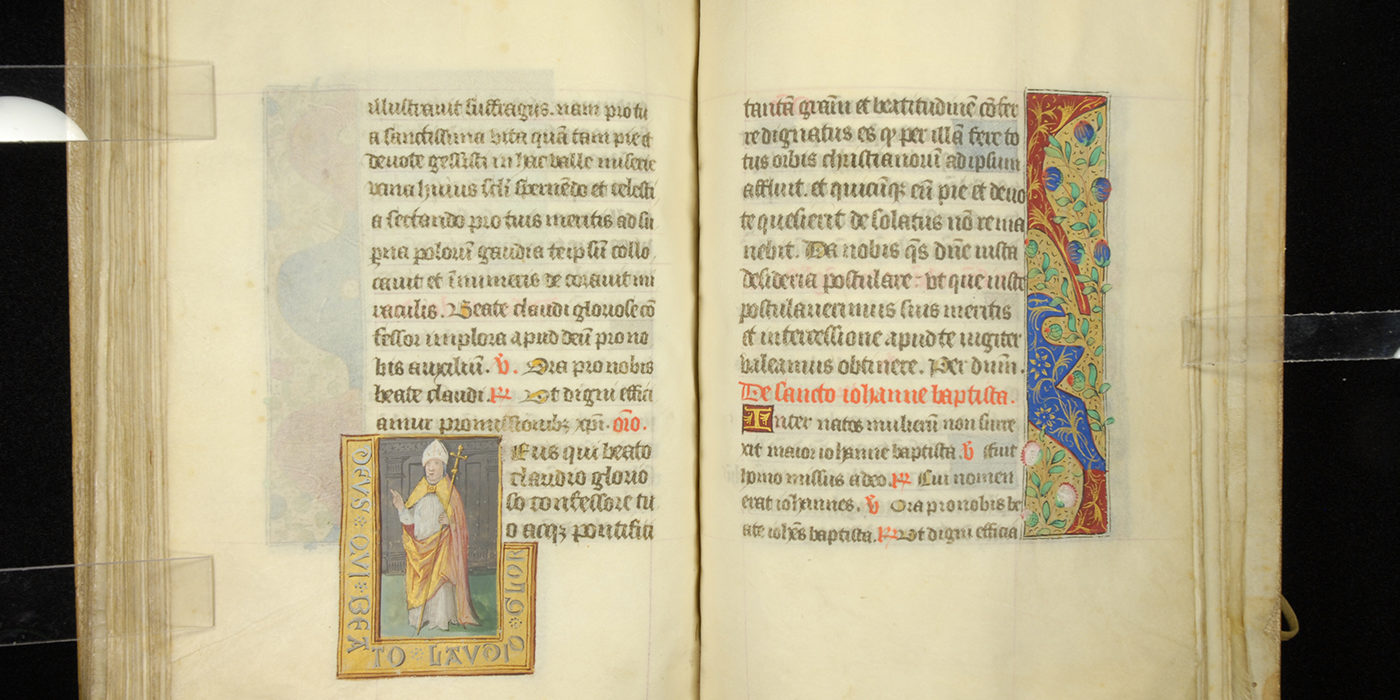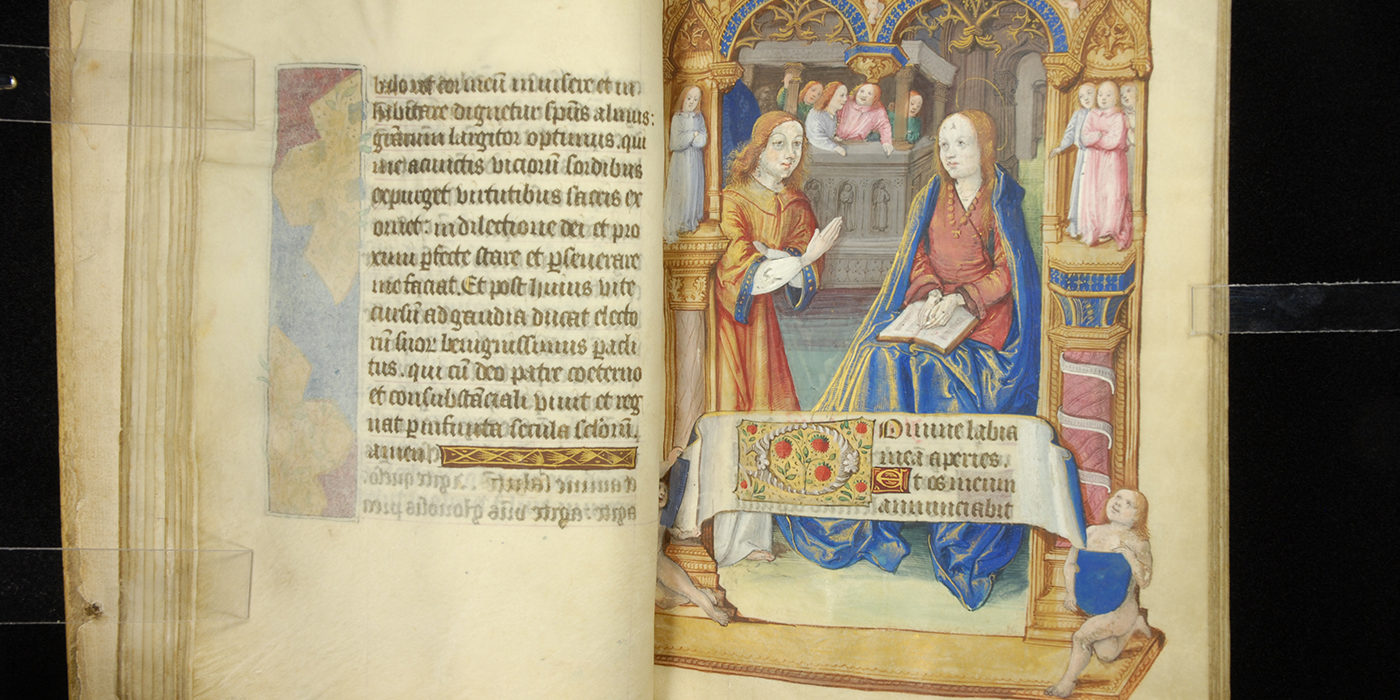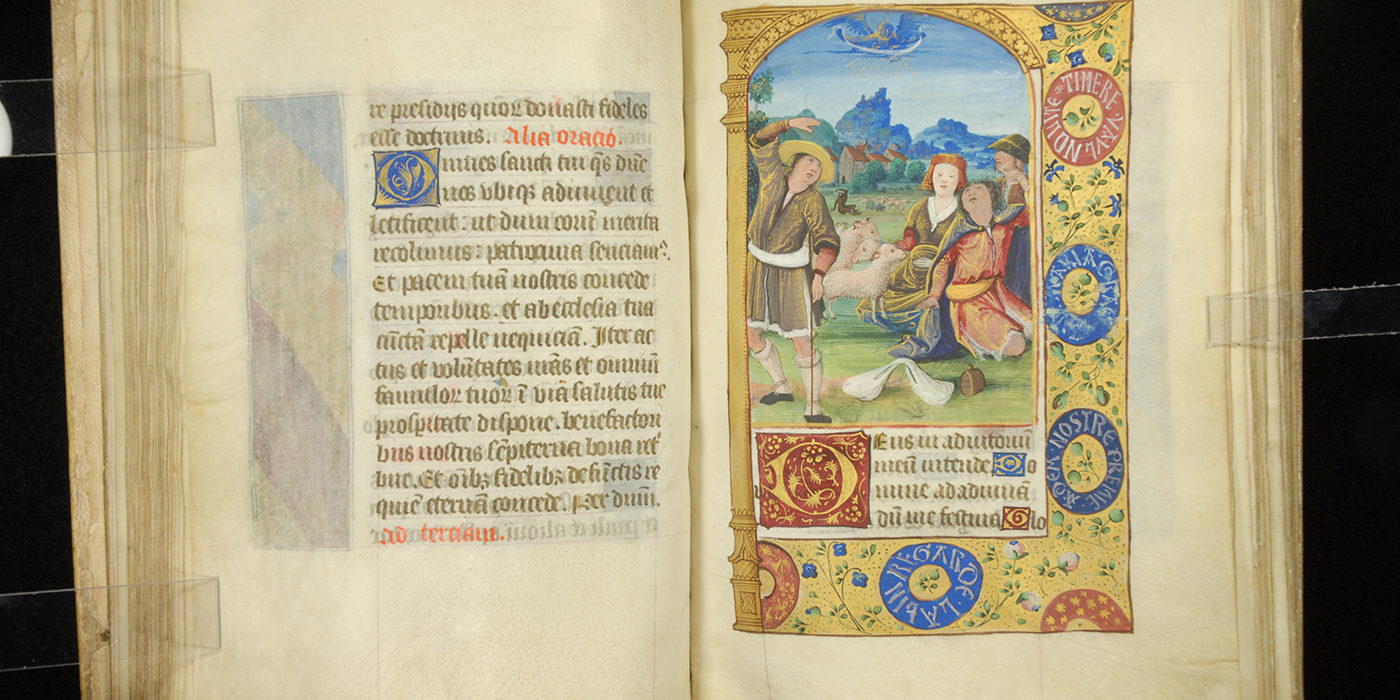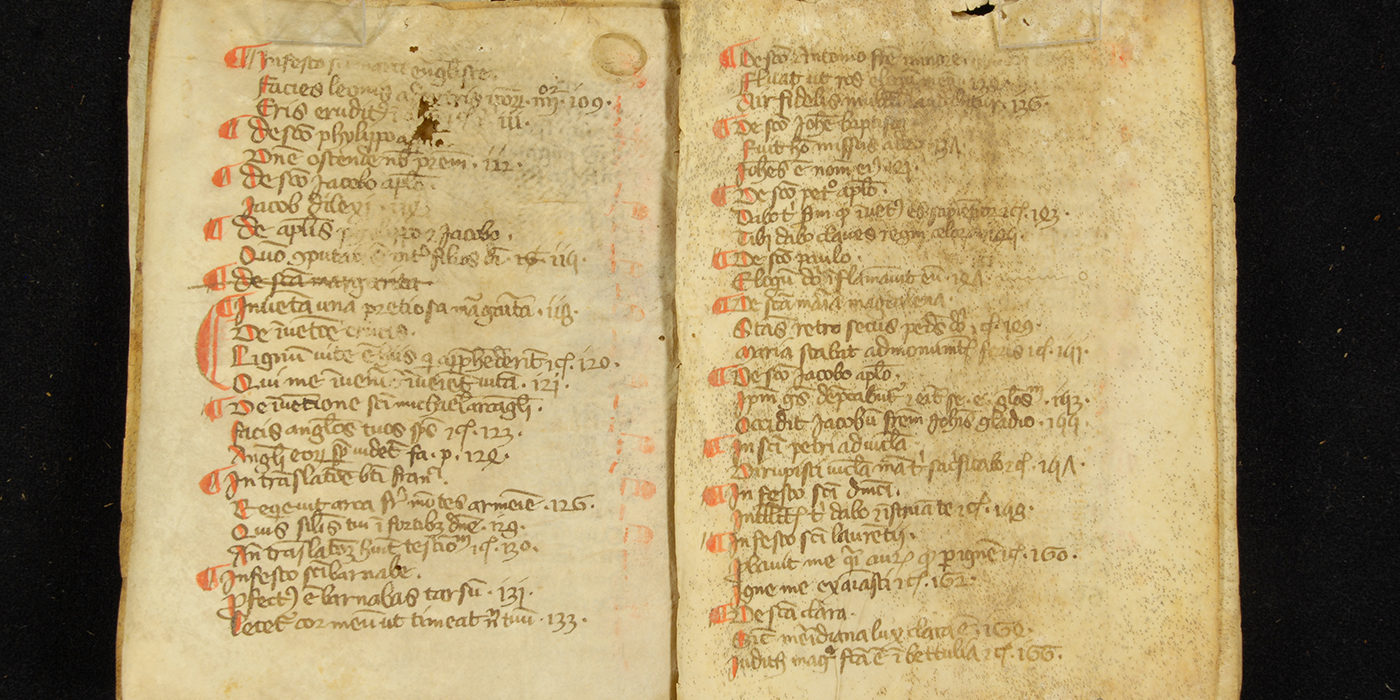-
Latin ms., England, ca. 1450
119 leaves (14.7 x 10.5 cm). Very pointed Gothic script. 18 lines. Gatherings mostly of 8. Text in Latin: Prayer for Henry VI, Calendar, Psalms, Litany, Hours of the Virgin, Office of the Dead, Hours of the Cross, Prayers. Several decorated borders and initials, one historiated. Binding: brown pigskin, 19th c.
The standard English style of illumination practiced during the fifteenth century is readily distinguishable from its counterparts on the continent. The surging, rhythmic leaf patterns, sharply pointed initials, and explosive vine ornament are as aggressive as the Gothic book hand of the text. The broad tones of pastel, the softly modeled, voluminous foliage, the spherical, lobed forms and golden discs are typical of English work from the 1440’s onward. The potential subtlety of this otherwise forceful style is apparent in the delicate rendering of a cleric’s head emerging from the soft leaf patterns of an initial painted in monochromatic tones of rose (45v). The first leaf done in a contemporary, though different, hand refers to King Henry VI (†1463), Henry VII (reigned 1485-1509), and the English “sweating sickness” that struck in the 1480’s. Furthermore, the calendar includes notations of deaths in the Paston, Berney, and Mumford families — one referring to the death of Margaret Paston whose will, according to an enclosed letter form the British Records Office, was written in 1482. Margaret’s husband John Paston was legal counsel to Henry VII. Hence the manuscript was likely in use by the last two decades of the century. A close association between the Pastons and Bromholm priory, Norfolk, suggests this as an early and possibly original provenance for the manuscript.
Provenance: Paston Family, Norfolk
View PDF of Manuscript
-
Roman usage. Latin ms., central France, ca. 1475
16 x 12 cm. Velvet black binding, sewn over 4 raised bands.
Documentation of this manuscript book exemplifies the difficulties encountered by a cataloguer in attempting to accurately describe a bound text. The cataloguer’s collation or description of the organization of the text block was: A6, B-D12, E6, F-H12, I-K8, L8(-1). When the book was disbound it was clear that the actual collation was: A8, B6, C-F8, G2, H4, I8, J-K6, L-M8, N8(-1), O6, P6(-1).
However, neither collation is an accurate reflection of how the book was originally constructed. When a map was made of the vellum leaves, i.e. hair or grain sides and flesh sides, it became clear that the previous restoration lost the original order. Some of the leaves were probably broken free when the book was taken to the 19th century binder, and he apparently could not read Latin. He guarded pairs of leaves to make folios and commenced to sew the book back together. It was decided to replace the existing vellum guards, most of which had come loose, with goldbeater’s skin, but to leave the order of the leaves as they were. Consequently, the text block is in the order received and the original location of leaves 53, 60, 61, 89, 94, and 95 is unknown. Leaf 101, which is conjugate with leaf 97, is incorrectly numbered and should be leaf 100.
View PDF of Manuscript
-
Roman usage. Latin ms., France, ca. 1525
Latin and some French. Vellum: 22 x 15.7 cm. 16 lines of text per page with an area (justification) of 11.8 x 7.4 cm. 162 folios. Blank page at front and back.
This Book of Hours is illustrated in a style which is a successful blending of Italian and Northern influences. The miniatures are set in architectural frames and typical is the division of the picture-space into two sections by a descriptive scroll. The total number of illustrations, large and small, is 35.
View PDF of Manuscript
-
Rouen usage. Latin ms., N. France, ca. 1475
162 leaves (18.5 x 12 cm.) Pointed Gothic script. 15 lines. Gatherings mostly of 8. Text in Latin and French: Calendar, Hours of the Virgin, Psalms, Litany, Prayers for Souls in Purgatory, Office of the Dead, Passion according to Matthew, Prayers, Gospel lessons, 15 articles of Faith. 13 large miniatures with border decoration. Binding: brown calf with gold-tooled decoration, medallions with the Crucifixion (front) and Annunciation (back) and the name “Françoise Boucher”, 17th c.
Of the various centers of illumination in northern France during the late fifteenth century, Rouen was undoubtedly the most productive source for lavishly decorated Books of Hours. Large numbers of these manuscripts betray a homogeneous but elegant standard of production less inclined to originality than conspicuous display. The unrestrained use of mat gold paint, the introduction of stock donor portraits, and a rather precious figure style are typical features of the Rouen school. We can infer that division of labor within workshops was especially common by this time as a means of meeting the inflated demand for prayerbooks. Two sets of donor portraits appear in this manuscript, one included in the original stages of production — a young woman in prayer in the Pietà with a knight kneeling in the border (135r). Such figures are of a general, anonymous type and indicate a book offered for sale on the open market. The knight’s armor was modified to bear the insignia of the arms accompanying the second set of donors added shortly after. The second pair is located beneath the Annunciation (13r). Curiously, the Annunciation itself contains two additional figures (one crowned with a coronet) behind the Virgin and Gabriel. The implications of this odd variation in a standard subject are unclear.
Provenance: The de Melleu family (inscription); Françoise Boucher.
View PDF of Manuscript
-
Latin ms., N. France, 1st qtr. 16th c.
127 leaves (15.3 x 10.3 cm.) Bâtard script. 22 lines. Gatherings mostly of 8. Text in Latin and French: Calendar, Gospel Lessons, Obsecro te, O Intemerata, Stabat Mater, Hours of the Virgin, of the Passion, of the Holy Spirit, Psalms, Litany, Office of the Dead, Prayers to Saints, Passion according to John. 12 large and 27 small miniatures, many decorated borders and initials. Binding: red velvet, 18th c.?
By the turn of the sixteenth century manuscript illumination was well into its final phase. and-made Books of Hours had to compete with less expensive printed editions available in large numbers by this time. The richly illuminated vellum codex had become a pretense in an era of rapidly changing values. Here the miniatures are set in architectural borders that overtly define the frame as a window opening into space. The figures are repetitive and graceless, but colorfully rendered and highlighted in gold. The style and calendar point to northern France, possibly the flourishing school of Rouen. St. Hunna (April 15), included in the calendar, was only canonized in 1519. Hence the manuscript may have been written after that date, late in the first quarter of the century.
View PDF of Manuscript
-
Paris Use, France, early 15th c.
152 leaves (17 x 12.5 cm.) Pointed Gothic script. 14 lines. Gatherings mostly of 8. Text in Latin and French: Calendar, Gospel Lessons, Seven salutations to St. Barbara (inserted), Hours of the Virgin, Psalms, Litany, Hours of the Cross, of the Holy Spirit, of the dead, Fifteen Joys of the Virgin, Prayers. 10 miniatures, 2 historiated initials and ivy vine borders with gold leaf. Binding: French, mottled brown calf with gilt ornament, 18th c.
The strength of Parisian influence during the late 14th and early 15th centuries drew talented illuminators from many outlying regions. The influx of masters from the north, especially Flanders, helped bring about distinctive changes in French style — the mixture of Gothic elegance with emerging currents of an earthy naturalism. The spiraling ivy vines of gold and refined page design in this manuscript are counterpointed by an often course figure style and blunt realism that typify the personalized devotional imagery in Burgundian regions. A subject such as God the Father in Majesty (74r), portrayed in an elegant hieratic style, contrasts with the simple rusticity of the Adoration of the Magi (50r). The color scheme tends to rich blues, mauve, and orange. Dour facial expressions, heavy-lidded eyes, and decorative backgrounds associate this manuscript with the workshops of the Boucicaut and Egerton Masters active in Paris during the early decades of the 15th century.
Provenance: Chas. W. Reynell (inscription); Scribner’s, N.Y.
Mr. and Mrs. S. Eberly Thompson collection (Ms. 5)
View PDF of Manuscript
-
Troyes use, 3rd qtr. 15th c. N. France
H132 leaves (17.5 x 13 cm) Pointed Gothic script. 18 lines. Gatherings mostly of 8. Text in Latin and French: Calendar, Gospel Lessons, Hours of the Cross, of the Holy Spirit, of the Virgin, Obsecro te, O Intemerata, Psalms, Litany, Office of the Dead. 5 large miniatures, 10 historiated initials, compartmentalized borders with fruit, flowers, birds, animals, and grotesques. Binding: mottled brown calf with gilt tooling. 18th c.
The courtly, decorative style of northern France tends increasingly to approach the book as an ornament. Dazzling displays of gold and jewel-like colors enliven the miniatures and border designs. Borders are commonly divided into compartments with alternating background.
View PDF of Manuscript
-
Roman Use, Latin ms., Florence, c. 1475
228 leaves (13 x 9 cm). Rounded Italian Gothic hand. 13 lines. Gatherings mostly of 10. Text in Latin: Calendar, Hours of the Virgin, Office of the Dead, Hours of the Passion, of the Cross, Psalms, Litany. Two miniatures and four historiated initials, many lavishly decorated initials and borders. Binding: vellum.
This exquisite little Book of Hours is a fine example of illumination as practiced at the heart of the Italian Renaissance. The Italian approach to the figure and composition is restrained and elegant, less vigorous and diffuse than Flemish naturalism of the same period. The borders are bold and brilliant in color. The floral decorations, vibrant initials, and delicately attenuated figure style are characteristic of Florentine work during the second half of the 15th century. The miniature style is related but not identical to works by Francesco d’Antonio del Chierico and Attavante, both active during this period. On general stylistic grounds the manuscript should be dated around the 1470s.
Provenance: House of Farnese; Signor Cattenacio (1736); Joachim Besozzi, Abbot of Santa Crucis if (both owners identified in an inscription on an enclosed vellum leaf); Scribner’s, N.Y.
Mr. and Ms. S. Eberly Thompson collection (Ms. 7)
View PDF of Manuscript
-
Roman Use, Latin ms., Flanders, last qtr. 15th c.
149 leaves (13.5 x 10 cm) Burgundian bâtard script. 14 lines. Gatherings mostly of 8. Text in Latin: Hours of the Cross, of the Holy Spirit, Masses, Gospel Lesson, Hours of the Virgin, Psalms, Litany. 34 miniatures, borders of acanthus and flower sprays, and illusionistic borders displaying flowers, insects, etc. Binding: French red morocco with gold tooling. 18th c. Modern solander case.
In flanders the last phase of manuscript illumination is marked by a dramatic redefinition of the relationship between texts and decoration. The school of illumination centered in the major artistic capitals of Ghent and Bruges drew heavily on contemporary panel painting as a source for miniature compositions. Complex architectural interiors and detailed landscapes reflect the naturalism introduced by Jan van Eyck earlier in the century and developed by Roger van der Weyden, Hugo van der Goes, Hans Memling, and Gerard David. in this manuscript, for example, the Virgin and Child with Angels (25v) is derived from altarpiece compositions like those of Memling. Many subjects not previously included in Books of Hours were introduced by these illuminators. The blue and gold acanthus patterns with sprays of flowers and fruit typical of earlier Flemish illuminators are retained on some leaves. But a new style in which the entire leaf is conceived as an illusionistic scenario dominates most of the illuminated pages. In this later style the border panels are treated like display cases with foliage and fauna scattered over the surface in colorful arrangements. These sill-life frames often intrude on the pictorial space of the miniatures. Alternatively, the text is frequently shown suspended in front of an open narrative landscape. Such playfulness tends to subordinate the text and betrays the widening gap between the illuminator’s more illusionistic aesthetic and the inherent two-dimensional restrictions of the book format. The style of the borders and the doll-like figure types show close affinities with manuscripts grouped around the Prayerbook of Mary and Maximilian I. But the less painterly landscapes and lanky proportions of many figures are closer to manuscripts done by the Master of Edward Iv during the 1480s for the great patron Louis of Bruges. Both trends are current in the Ghent/Bruges region during the 1480s and 90s, a likely date for this manuscript.
Provenance: Fovine family (inscription in an Italian hand, 1545-46); Jacques Comte de Foncina (inscription, 18th c. ?)
View PDF of Manuscript
-
Before 1520
Printed by Thielman Kerver (fl 1497-1524)
The many Books of Hours printed by Phillipe Pigouchet (fl 1488-1518), Thielman Kerver, Antoine Vérard (fl 1485-1514) and others represent the highest artistic development of the printed lay prayer book. Medieval in conception, characteristically every page of the Hours had a full border, often made up of many small wood- or metalcuts, the two being difficult to distinguish. Some were printed on parchment and carefully illuminated.
View PDF of Manuscript

